Blog
HubSpot Partner Management: 7 Best Practices For Scaling
Partner-led growth depends on empowering partners to work alongside direct sales to drive customer acquisition and revenue — and tight integration between your CRM and partner workflows is essential to get this right.
This seamless integration creates a unified view of leads and opportunities, allowing both internal teams and partners to collaborate seamlessly and avoid duplicating their efforts.
Furthermore, integrated systems enable accurate deal registration, attribution, and tracking, which is critical for partner incentives and performance insights.
With synced workflows, partners can register deals directly, co-sell with your team, and stay aligned through shared timelines and updates.
Additionally, CRM integration enables automated notifications, streamlined onboarding, and enhanced forecasting (by including partner pipeline in revenue projections).
The key benefits of tightly integrating your CRM and partner workflows?
Less friction, shorter sales cycles, and better partner trust.
Ultimately, it allows you to scale your partner ecosystem efficiently while maintaining transparency, accountability, and data-driven decision-making — all of which are vital to a successful partner-led growth strategy.
This is why companies are increasingly shifting from standalone PRM portals to CRM-first experiences like Introw — which integrates with popular CRMs, including HubSpot — to streamline their partner collaboration.
This approach meets partners where they work and aligns them more closely with internal sales processes.
Ready to scale your partner management this year?
⬇️ In this guide, we'll cover why HubSpot is a highly effective platform for partner management and take you through seven must-have best practices for scaling in 2025.
Can You Manage Partners in HubSpot? (Spoiler: Yes — with the Right Setup)
HubSpot doesn't have native PRM, but it offers several features that can be useful for SaaS partner management projects.
For example, the platform supports custom objects, labels, and workflows.
All of these elements are super useful for companies running small partner management projects.
The problem arises when you want to scale.
Indeed, most partner programs will quickly outgrow manual tagging and disconnected forms.
Once you get serious about your partner program, you need a PRM that is tailor-made for managing and scaling these schemes.
At the same time, you don't want to silo your partner management efforts from your CRM — this would create data disconnects, limiting visibility into partner-driven deals and slowing collaboration.
The solution?
Invest in tightly CRM-integrated PRM tools like Introw.
This way, you fill the PRM gap natively inside HubSpot and give your partnerships the best possible chance of flourishing.
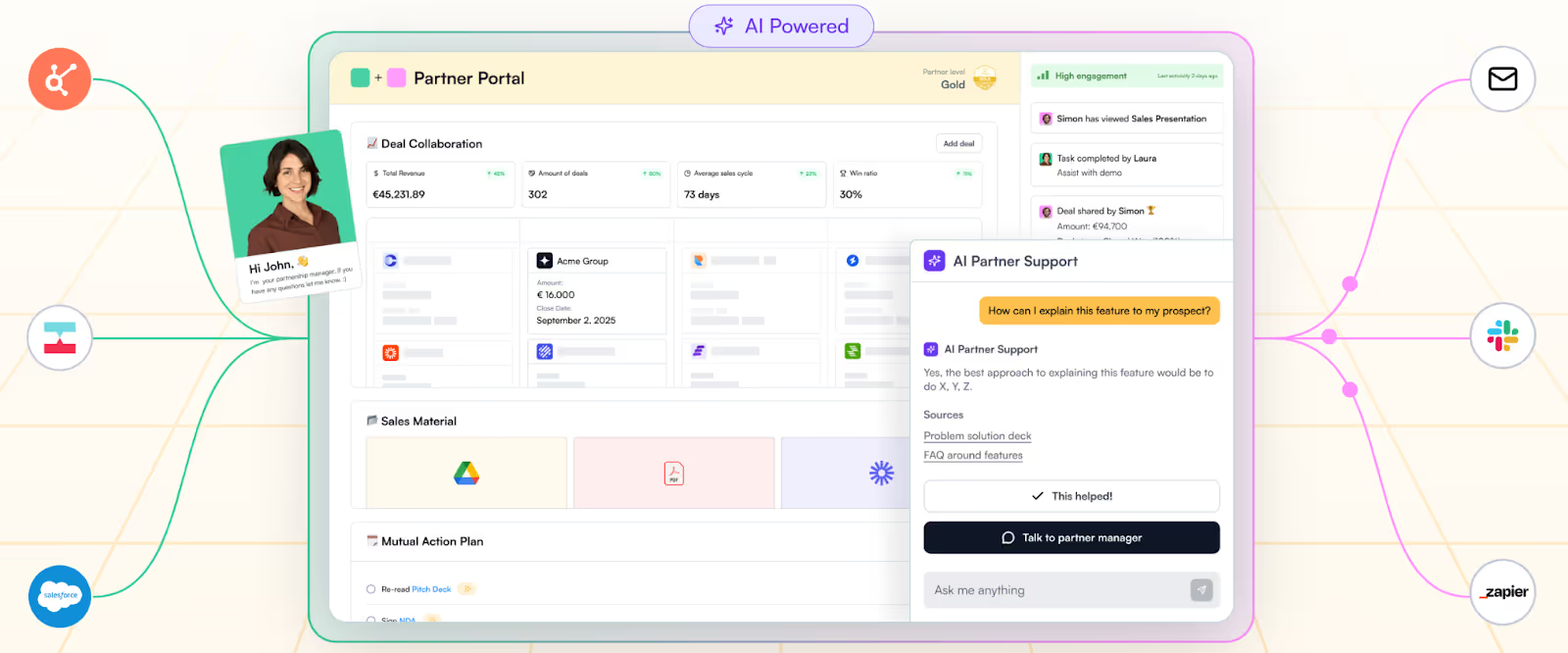
Why HubSpot Is a Strong Foundation for Partner Management
Many SaaS teams already rely on HubSpot as their central source of truth for customers, deals, and marketing.
But increasingly, partner managers are realizing HubSpot can also be a superb command center for their partner programs — as long as they configure the platform in the right way.
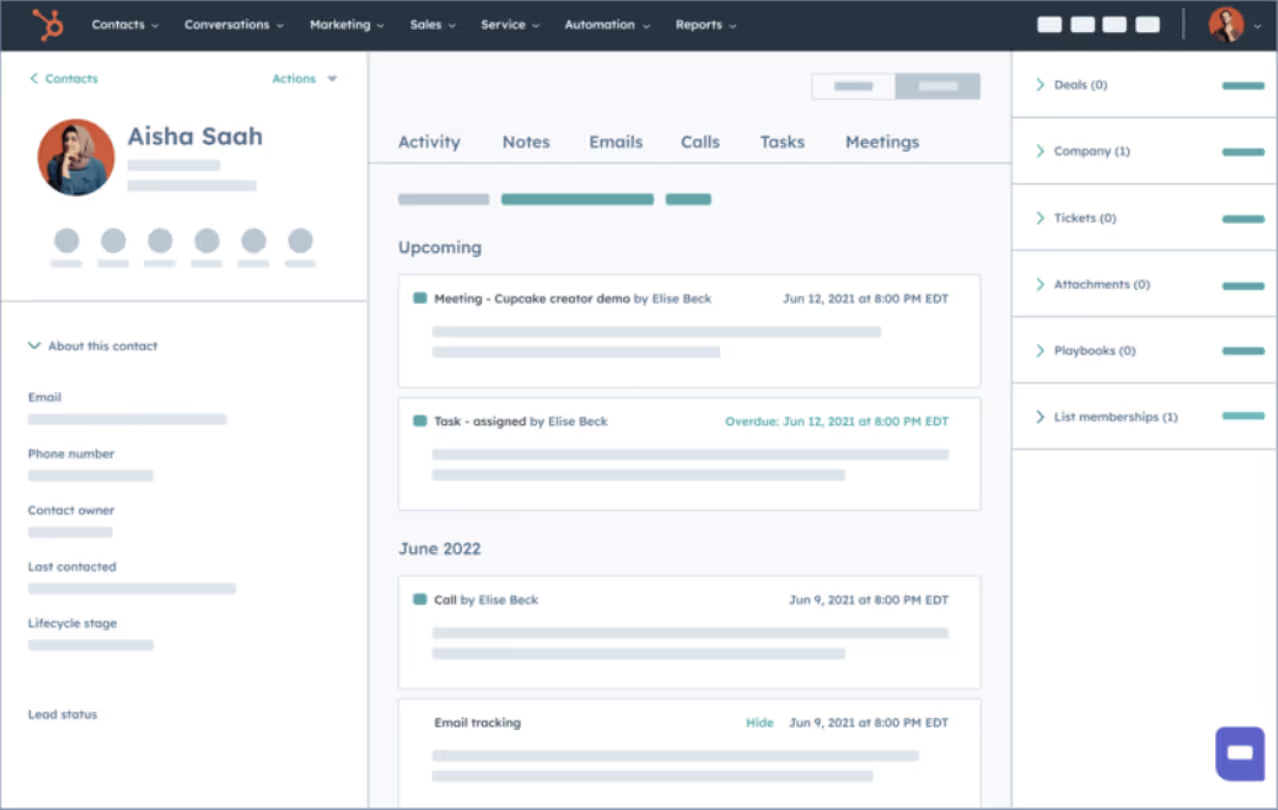
Here's why HubSpot makes sense as a foundation for partner management in 2025:
- Unified CRM: HubSpot consolidates marketing, sales, and service data — giving RevOps and partner teams shared visibility
- Custom Properties & Objects: You can track partner types, partner-sourced deals, referrals, and more — without duct-taping separate systems
- Automation: Workflows make it easy to route leads, assign reps, or trigger partner engagement emails
- Integrations: Certified apps like Introw turn HubSpot into a fully featured PRM, removing the need for standalone portals or duplicate tracking
- No-Code Setup: You can scale your partner ops without custom dev work or heavy training
In short, if HubSpot is already your CRM, there's no reason to manage your partner program outside of it.
Instead, plug in a PRM like Introw, and you'll gain a partner-ready ecosystem inside your CRM — one that works for RevOps, Sales, and Partner Managers alike.
7 Must-Have HubSpot Partner Management Practices for 2025
Ready to scale your partner program with Hubspot?
Here are seven vital HubSpot partner management practices you should be following for success in 2025.
1. Automate Partner Onboarding with Forms + CRM Sync
This one will save you a lot of time!
Did you know you can use Introw to push form data (e.g. "Become a Partner") directly into HubSpot?
First, connect Introw to HubSpot to enable seamless data synchronization.
This integration allows form submissions, such as partner applications, to be pushed directly into HubSpot.
You can then use HubSpot's automation tools to trigger actions upon form submission.
For instance, automatically create a contact or company record, assign tasks, or send follow-up emails.
2. Enable Easy Deal & Lead Registration (No HubSpot Login Needed)
Introw allows for off-portal collaboration, which makes life much easier for your partners.
Indeed, your partners don't even need to log in to HubSpot in order to submit deals or register leads.
Instead, they can submit deals via a form, Slack or email.
The details are then auto-mapped to HubSpot, which acts as your single source of truth.
3. Collaborate on Deals Inside HubSpot with CRM Cards
Using CRM cards from Introw, teams can collaborate on partner-sourced deals directly inside HubSpot.
These embedded cards show deal details, partner info, and updates in real-time — without switching tools.
This means your partner's comments are automatically turned into CRM notes
Real-time sync keeps the deal's status, details, and updates aligned with your HubSpot pipeline, enabling smooth, in-CRM collaboration.
This streamlines communication, boosts visibility and keeps sales and partner teams aligned throughout the deal cycle.
4. Track Partner Performance in Real-Time
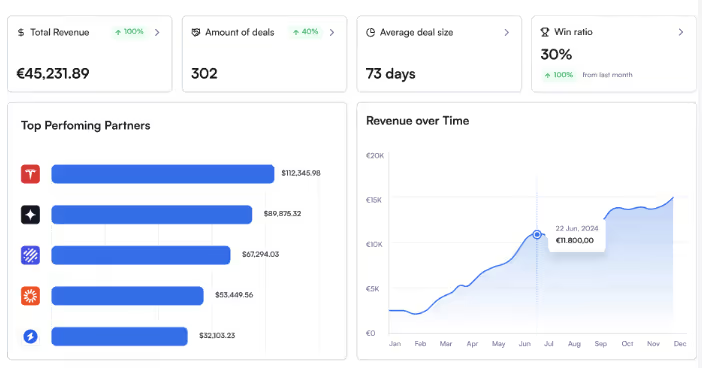
The success of your partner strategy hinges on data analysis.
Tracking partner performance in real-time is crucial to help you identify top performers, spot bottlenecks, and optimize your partner strategy as deals progress.
Indeed, without a sophisticated tracking and data analysis system, you're just guessing at what works and hoping you're right.
But with the right tools in your arsenal, you unlock faster decision-making, more accurate forecasting, and effective incentives — driving accountability, growth, and stronger partner relationships across your ecosystem.
Fortunately, Introw and HubSpot work together to make real-time data analysis easy.
Introw generates dashboards based on HubSpot data.
Set up dashboards based on metrics that speak to your goals — for example, revenue, activity, pipeline, or deal data.
5. Engage Partners Off-Portal via Email & Slack
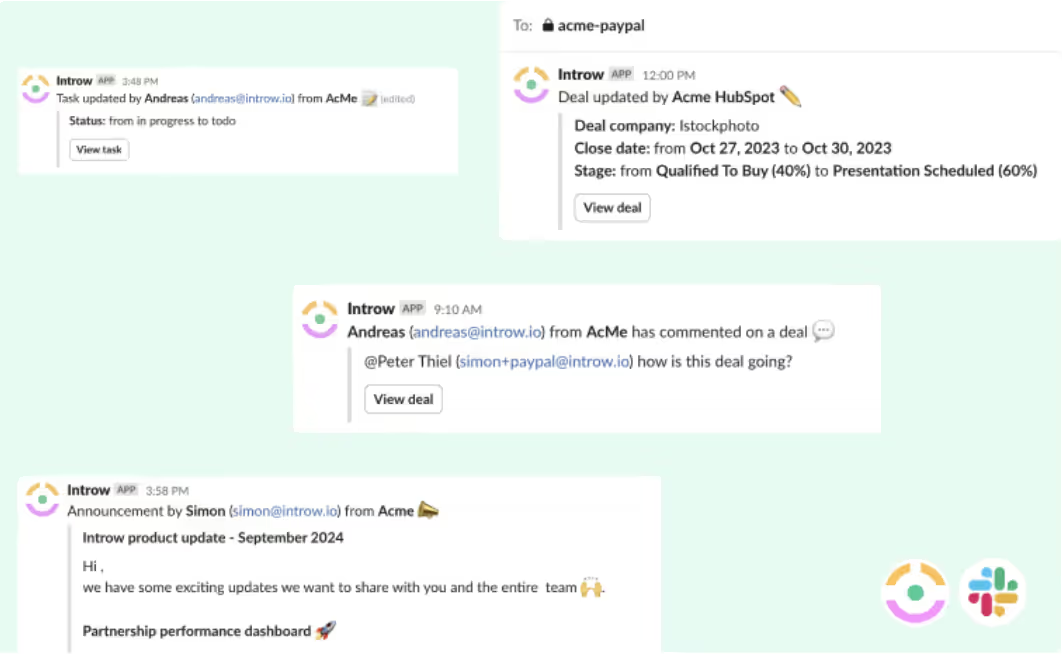
One of Introw's most partner-friendly features is that it allows you to engage your partners off-portal via email and Slack.
This means partners don't need to log into their portal to communicate or collaborate with you.
Instead, they receive real-time notifications, can comment on deals, and stay in the loop — all off-portal — making collaboration faster, easier, and more integrated into their daily workflows.
6. Customize Experiences by Partner Type
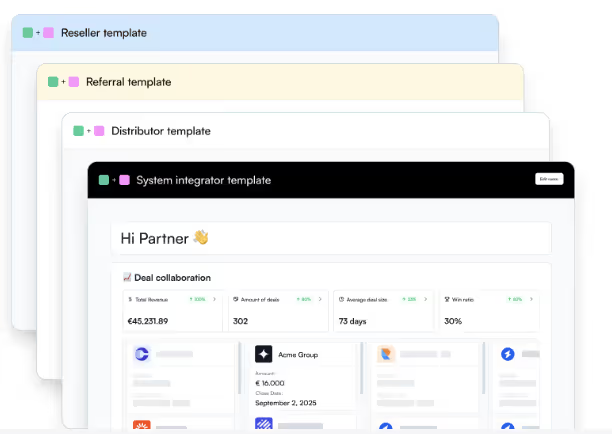
In 2025, personalization is crucial when it comes to engaging your partners.
Deliver an irrelevant or jarring experience, and partners could lose trust in your offering and become more reluctant to recommend you.
Introw supports dynamic views and objects in HubSpot, which allows you to customize partner experiences by type.
For example, you can tailor onboarding flows, forms, content, and deal stages for different partner types, like partner submitted referrals, a successful reseller channel, or MSPs.
Simply segment partners within HubSpot and Introw, then deliver relevant experiences and workflows that match their role, ensuring higher engagement and more effective collaboration across partner types.
7. Automate Commission Tracking & Payouts
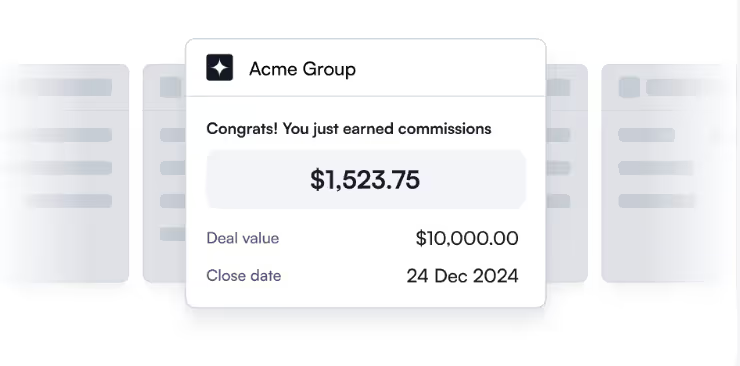
Connect Introw with your HubSpot CRM to automate commission tracking and payouts.
As deals close, Introw tracks which partner influenced each one, calculates commissions based on preset rules and logs the data.
You can then use CRM triggers to automate payout workflows or give partners visibility over their commissions.
This ensures accuracy, transparency, and timely rewards.
Why Introw Is the Best HubSpot PRM Integration for 2025
Introw stands out in 2025 as the ultimate PRM integration for HubSpot, delivering unmatched efficiency, partner experiences, and growth capabilities.
Here's why it's the best partner relationship management tool integration with HubSpot:
- HubSpot Certified App: Introw is trusted and verified by HubSpot, ensuring a smooth, secure integration.
- Personalized partner portals created in minutes: Launch clean, branded portals for each partner quickly — no technical setup required.
- Keeps HubSpot as the single source of truth: All partner data, leads, and deal activity sync directly into HubSpot, eliminating the need to manage a separate PRM system.
- No partner logins required: Partners can view, register, and collaborate on deals via shared links — no friction, forgotten passwords, or onboarding headaches.
- Real-time deal + engagement sync: Instantly reflects partner-submitted leads and activity in HubSpot, giving your sales team live visibility.
- GDPR-ready, ISO27001 and SOC2 certified: Designed with enterprise-level security and global compliance in mind.
- Works across all HubSpot plans (Sales, Service, CRM): Fully compatible with the entire HubSpot suite, so you can support partner workflows wherever your teams operate.
🚀 Launch Your HubSpot Partner Portal in Minutes — Book a Demo!
Conclusion
If HubSpot is already your CRM, why not make it your partner system too?
With Introw, you can scale partner programs without silos, clunky portals, or extra logins.
Save RevOps time, align with Sales, and drive more revenue from your ecosystem.
✅ Ready to simplify partner management in HubSpot? Get a personalized demo
What is PRM? Guide to Choosing Your Next PRM in 2025
Managing partner relationships shouldn’t feel overwhelming, but without the right system, it often does. If your company sells through channel partners, resellers, affiliates, or integration partners, you know the challenge of keeping everyone aligned. Deals get lost in emails, marketing materials go unused, and partner engagement drops when there’s no clear structure in place.
That’s where Partner Relationship Management (PRM) software comes in — giving businesses the tools to streamline business processes, improve partner collaboration, and drive more revenue.
But with so many options available, how do you choose the right PRM platform for your needs? This guide breaks it all down, helping you find the best PRM solution to scale your partner programs, keep partners engaged, and ultimately grow your indirect sales channels.
What is PRM (Partner Relationship Management)?
Partnerships are at the core of many successful businesses, but managing those relationships efficiently is another story. What is PRM? Simply put, Partner Relationship Management (PRM) is a software designed to help businesses streamline partner collaboration, boost partner engagement, and maximize the potential of channel partners.
If your business relies on partners — whether resellers, affiliates, integration partners, or distributors — you’ve probably hit a point where managing them with spreadsheets, email threads, or a patchwork of tools just isn’t cutting it anymore. That’s where PRM software comes in.
A PRM system helps you organize, automate, and optimize everything related to partner relationships. It’s like a customer relationship management (CRM) platform, but built for partnerships instead of direct customer sales. With a PRM, you can onboard partners, share marketing materials, track performance, manage deal registration, and keep partners engaged — all in one place.
How PRM Differs from CRM
Many businesses assume that a CRM software can handle their partner relationships the same way it manages customer relationships. But while a CRM platform is built for direct sales teams to track leads and customer interactions, a PRM solution is designed for indirect sales channels and partner programs. Customer relationship management focuses on enhancing customer satisfaction, loyalty, and retention by managing customer interactions and data, whereas PRM is tailored for managing partner relationships and indirect sales channels.
A PRM helps you:
- Manage multiple partner programs — Whether working with reseller partners, independent software vendors, or solution providers, a PRM ensures smooth coordination.
- Automate partner onboarding — Ensuring new partners have access to the necessary resources to succeed.
- Streamline business processes — Reducing manual data entry while improving visibility into partner activities.
- Enable deal registration — Ensuring partner sales and lead management are well-documented and tracked separately from direct sales.
Why Do You Need a PRM?
The benefits of partner sales and a strong partner relationship management system go beyond just having more hands on deck. A well-managed PRM solution leads to better business processes, increased customer satisfaction, and ultimately, more revenue.
Companies working with channel partners, resellers, or affiliates know that partnerships can be a massive revenue driver — but only if they’re well-managed. Without a PRM platform, things can get messy:
- Tracking leads and deals? Scattered across emails, Slack, and random spreadsheets.
- Marketing materials? Lost in email threads or outdated PDFs.
- Onboarding new partners? Inconsistent and frustrating.
- Measuring partner performance? Nearly impossible without accurate sales analytics.
A PRM system eliminates these headaches by providing a central hub to manage partner relationships, keep partners informed, and streamline business processes — leading to higher revenue growth and less manual data entry.
💡 Did you know? Partner-led deals tend to be 32% bigger and have a 2.8X higher win rate than deals closed by a direct sales team alone.
How to Choose the Right PRM for Your Business
Choosing the right PRM software isn’t just about getting the latest technology — it’s about finding the right PRM platform that aligns with your business goals, partner recruitment strategies, and revenue growth objectives.
Not all PRMs are created equal. Some are clunky and take months to implement, while modern PRMs (like Introw) can be up and running in minutes. Here’s how to find the best PRM solution for your business.
1. Key Features to Look for in a PRM System
A great PRM platform should help you manage partner relationships without adding extra headaches. Here are the key features to look for:
- Partner Onboarding & Training – Get new partners set up quickly with structured onboarding processes and the right business tools.
- Deal Registration & Lead Management – Ensure channel partners can submit leads easily, reducing channel conflict.
- Performance Tracking & Metrics – Keep tabs on sales performance, revenue targets, and partner engagement. Monitoring partners' performance through business intelligence-based dashboards can help analyze partner activities and optimize strategies, fostering better collaboration and driving revenue growth.
- Content & Marketing Material Management – Ensure partners always have access to brand guidelines, marketing materials, and incentive programs.
- Seamless CRM Integration – A PRM platform should sync with your CRM systems like Salesforce or HubSpot.
- Communication & Collaboration Tools – Features like Slack notifications, automated emails, and portal updates ensure partners stay engaged.
💡 Bonus: Look for PRM systems that integrate with tools like Crossbeam, Slack, and Zapier for better automation.
2. Involving the Right Stakeholders in Partner Onboarding
Before investing in a PRM system, make sure you involve the right people in your organization:
- Sales & Channel Managers – They need full visibility into partner sales, lead management, and pipeline performance.
- Marketing Teams – They’re responsible for partner engagement strategies, marketing collateral, and sales enablement materials.
- RevOps & CRM Admins – They ensure seamless CRM integration with business processes.
- Your Partners – Ask your external partners what they actually need to be successful.
3. Prioritizing Time-to-Value for Partner Performance
Some PRM solutions take 4-6 months to fully implement — leading to unnecessary delays and revenue loss. Long setup times also mean higher development costs, lost sales opportunities, and increased frustration for channel managers and partners who are left waiting. Modern PRMs (like Introw) can be deployed in minutes, ensuring you see results faster and allowing partner programs to start contributing to revenue growth almost immediately.
💡 Every day without a PRM is a missed opportunity to drive more revenue.
4. Choosing a CRM-First PRM Platform
Most businesses already rely on a CRM system to track customer and partner activities. The best PRM systems don’t replace your CRM — they enhance it. Look for:
- 2-Way CRM Sync – So customer relationships and partner sales data are always accurate.
- Lead & Deal Syncing – So partners don’t have to manually enter sales opportunities.
- Support Ticket & Collaboration Features – PRMs should go beyond just deal registration.
- Built-In Analytics – Get instant insights into partner performance and sales metrics.
Why Introw is the Best PRM in 2025
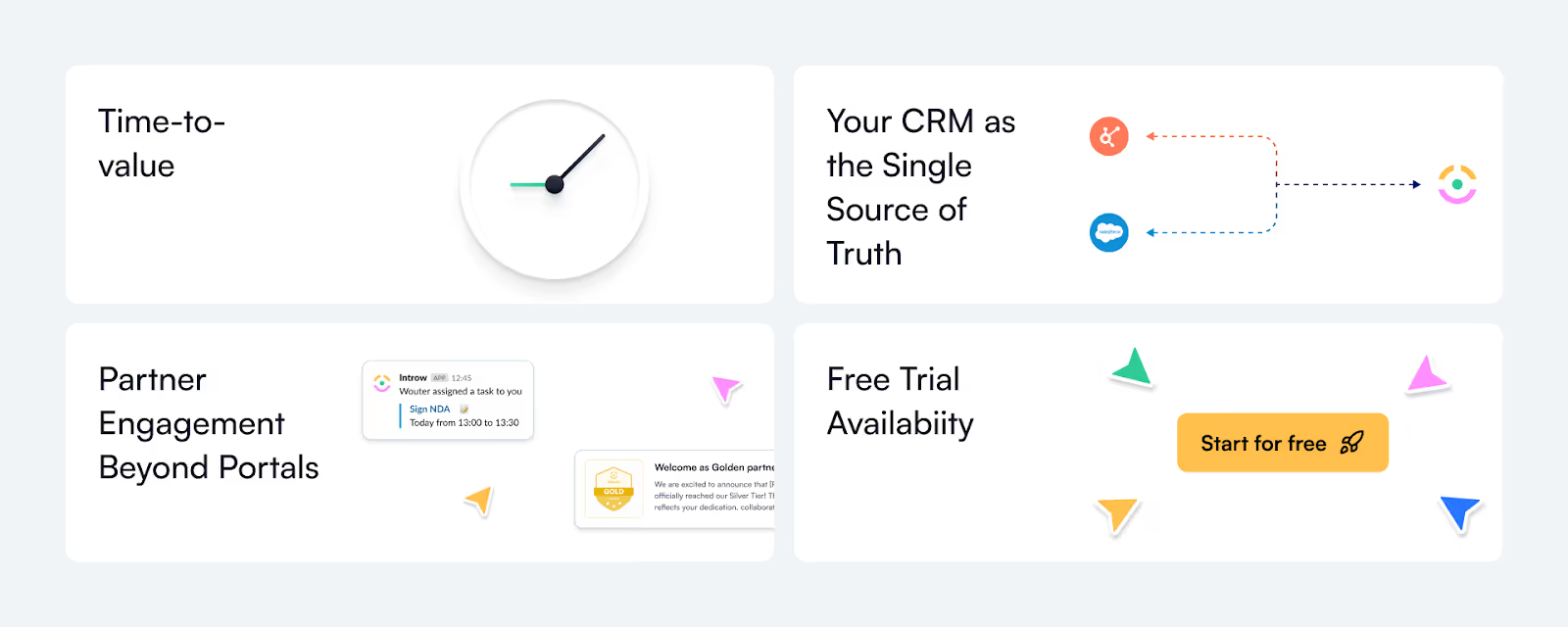
If you’re looking for a PRM solution that’s fast, easy, and actually built for modern partner relationships, Introw is a top choice. Here’s why:
- Fast Deployment – No need to wait months to get started.
- CRM-First Integration – Works seamlessly with your CRM platform.
- Designed for Engagement – Helps keep partners informed and active.
- Proven Track Record – Companies using Introw see higher partner adoption and sales growth.
Final Thoughts
A strong PRM platform isn’t just about ticking feature boxes — it’s about partner success, revenue growth, and streamlining business processes.
If you’re ready to scale your partner programs, drive more revenue, and improve partner engagement, investing in the right PRM system is a no-brainer.
Want to see how Introw can transform your partner programs? Request a demo or try it for free today!
FAQs about Choosing PRM
1. What is PRM, and how is it different from a CRM?
PRM (Partner Relationship Management) is software designed to help businesses manage partner programs, track partner sales, and optimize collaboration with channel partners, resellers, and affiliates. Unlike CRM software, which focuses on direct sales teams and customer relationships, a PRM system is built to support indirect sales channels by providing features like partner onboarding, deal registration, and performance tracking.
2. How do I choose the best PRM for my business?
When selecting a PRM platform, consider factors such as ease of implementation, CRM integration, automation features, and partner engagement tools. A good PRM solution should help you streamline business processes, reduce manual data entry, and improve partner collaboration. Look for features like 2-way CRM sync, marketing collateral management, and automated partner updates via Slack or email.
3. What are the key benefits of using a PRM solution?
A PRM system helps businesses manage partner relationships efficiently, leading to higher revenue growth, better sales performance, and improved customer satisfaction. Key benefits include:
- Automated partner onboarding – Get new partners up to speed quickly.
- Deal registration & lead tracking – Reduce conflicts and improve visibility.
- Performance management – Track partner success, revenue targets, and engagement metrics.
- Marketing & content sharing – Ensure partners have the necessary resources to sell effectively.
4. Why is Introw the best PRM solution in 2025?
Introw stands out as a modern PRM platform that prioritizes fast setup, seamless CRM integration, and partner engagement beyond the portal. Unlike traditional PRMs that require months of setup, Introw is ready to use in minutes. It also offers:
- 1-click CRM integration – Works effortlessly with HubSpot, Salesforce, and other CRM systems.
- Real-time analytics & reporting – Track partner performance and sales opportunities.
- Automated partner updates – Keep partners informed via Slack, email, or in-app notifications.
Latest articles
Introw PRM and Crossbeam integration
Looking to integrate account mapping data into your PRM? Introw leverages Crossbeam's overlap data to identify opportunities and share them with your partners instantly.
What is Crossbeam?
Crossbeam is a Partner Ecosystem Platform (PEP) that empowers SaaS companies to replace cumbersome spreadsheets with a streamlined system to identify overlapping customers and prospects in their partner networks. This approach is commonly known as "account mapping."
In simple: You connect your CRM, your partner connects their CRM. Crossbeam identifies overlapping data. Example: Your company has Acme Corp as a prospect, your integration partner has Acme Corp as a customer. Crossbeam will uncover this for you allowing you to ask for an introduction or intell about Acme Corp.
In 2024, Reveal and Crossbeam merged, creating a network that now connects over 30,000 companies, including Stripe, Intercom, HubSpot, and many others.

What is Introw?
Introw is an innovative Partner Relationship Management (PRM) platform designed to make managing partnerships easy, efficient, and impactful. It allows businesses to create and manage a partner portal in just minutes, with features like:
- Automated Deal and Lead Registration: Streamline workflows for registering and tracking deals all integrated with your CRM.
- Tiering and Commission Management: Automate partner tiers and commission payouts to encourage better engagement.
- Partner Enablement: Keep partners up to date and top of mind by giving them access to the right sales material and sending them announcements on autopilot.
- CRM Integration: Introw integrates seamlessly with platforms like Salesforce and HubSpot, keeping your CRM as the single source of truth.
- Real-Time Alerts and Nudges: Introw enables instant partner engagement via email and Slack, ensuring partners stay informed and motivated.
Unlike traditional PRMs, Introw starts from CRM data, and is set-up in literally minutes instead of months.
Why and How Does Introw Integrate with Crossbeam?
The integration between Introw and Crossbeam brings the best of both platforms together to enhance partnership collaboration and revenue potential. Here’s how it works:
- Seamless Connection: With just one click, Introw connects to Crossbeam, automatically matching your partners from both platforms.
- Streamlined Opportunity Sharing: Use Crossbeam's overlap data to identify opportunities and share them with your partners instantly through Introw.
- Automated Deal Attribution: Deals sourced through Crossbeam's overlap data are automatically attributed to the appropriate partner in your CRM.
- Real-Time Partner Engagement: Introw uses Slack and email to send timely updates on deal status or CRM changes, ensuring partners are always in the loop and engaged.
By combining Introw’s advanced partner management tools with Crossbeam’s powerful data-sharing capabilities, this integration creates a highly efficient system for driving partnership revenue and fostering collaboration.
Learn more and get started with the integration by creating an here.
Alternatively, schedule a 1:1 call to learn more through a personalized demo.
Introw becomes a HubSpot Certified App Partner 🏅
This milestone reinforces our mission: leveraging CRM-data as the single source of truth for partner collaboration.
Introw is helping over 1000 HubSpot users to launch a partner portal in minutes, all integrated with their CRM. This has resulted in an increased partner revenue & engagement for HubSpot customers (see Sandsiv case study).

Benefits of the HubSpot Integration
Certified integrations reflect a strong investment in product quality and customer experience, ensuring users can unlock greater value from their HubSpot workflows. Partners can collaborate in real-time on deals and get real-time updates, while resellers can even manage their own deals without needing a HubSpot account.
🪄By connecting HubSpot to Introw, all partner data sitting in HubSpot will come to life in no-time:
- You'll be aligned with your partners by collaborating on deals in your partner portal. Comments are being pushed as notes in your HubSpot.
- You'l be able to sync partners from HubSpot directly to Introw
- You'll be able to push form submissions (become a partner, support request, lead form & deal form) directly to HubSpot.
- Add other dynamic CRM-views based on HubSpot objects to your shared space (contacts, companies, leads or tickets)
Next to this, Introw integrates with contacts, product, quotes and more in order to keep HubSpot as the single source of truth for data management.
Introw Copilot in HubSpot
The HubSpot Copilot enables the partnership, sales, and marketing teams to seamlessly collaborate with their B2B partners directly within their CRM. Watch this short video to see how the Copilot workflow operates.
Laurens Lavaert, CTO at Introw, adds, “HubSpot has been an exceptional partner. Achieving certification on their marketplace reinforces our dedication to helping businesses streamline partner collaboration. With Introw, nearly 1000 HubSpot users are already simplifying their partner collaboration, and we’re excited to help thousands more maximize their success.”
HubSpot’s App Partner Program continues to grow its ecosystem of top-tier integrations, offering users powerful tools to expand their reach and streamline their operations.
Connect HubSpot to Introw now
- Create an account via: https://rooms.introw.io/signup
- Connect your CRM
- See the magic in action 🪄
About Introw
Introw is a partner relationship platform (PRM) that lets you launch a personalized partner portal in minutes—fully integrated with HubSpot (& Salesforce). Whether you work with resellers, referral partners, distributors, or implementation partners, Introw streamlines collaboration and boosts engagement without the hassle of traditional portals.
Introw raises €1M to launch Digital Partnership Rooms
Introw raises €1M
The Ghent-based tech start-up Introw, already helping dozens of companies to unlock partnership sales, raises €1M to create "Digital Partnership Rooms"
Early-stage fund Pitchdrive leads the €1 million round in Introw, joined by vetted angels such as Pieterjan Bouten (Showpad), Ewout Meyns (Hubspot) & Dieter De Mesmaeker (DataCamp).
Young entrepreneurs Andreas Geamanu (CEO), Laurens Lavaert (CTO) and Simon Van Den Hende (AI Engineer) founded the company in early 2023 together with “Netlog-maffia” serial entrepreneurs Lorenz Bogaert, Toon Coppens, Nicolas Van Eenaeme and Vincent Verlee.
They are on a mission to make partnership collaboration easy by allowing partners to collaborate in shared spaces.
"There is only 25% adoption on current partner relationship management (PRM) solutions. With Introw partners don't need an account which results in up to 80% partner adoption," says co-founder Andreas Geamanu.

About the Challenge
The founders saw the challenges sales teams faced when trying to collaborate with B2B partners. Driven by these challenges, the founders set out to bridge the gap and forge a new path for B2B ecosystem sales.
”We saw a huge drive in the founders to solve a pain they had experienced personally. Combining the technical (AI) expertise with B2B sales expertise will be a magical potion that can lead to a huge shift in the way companies work with partners today” Wim Derkinderen at Pitchdrive.
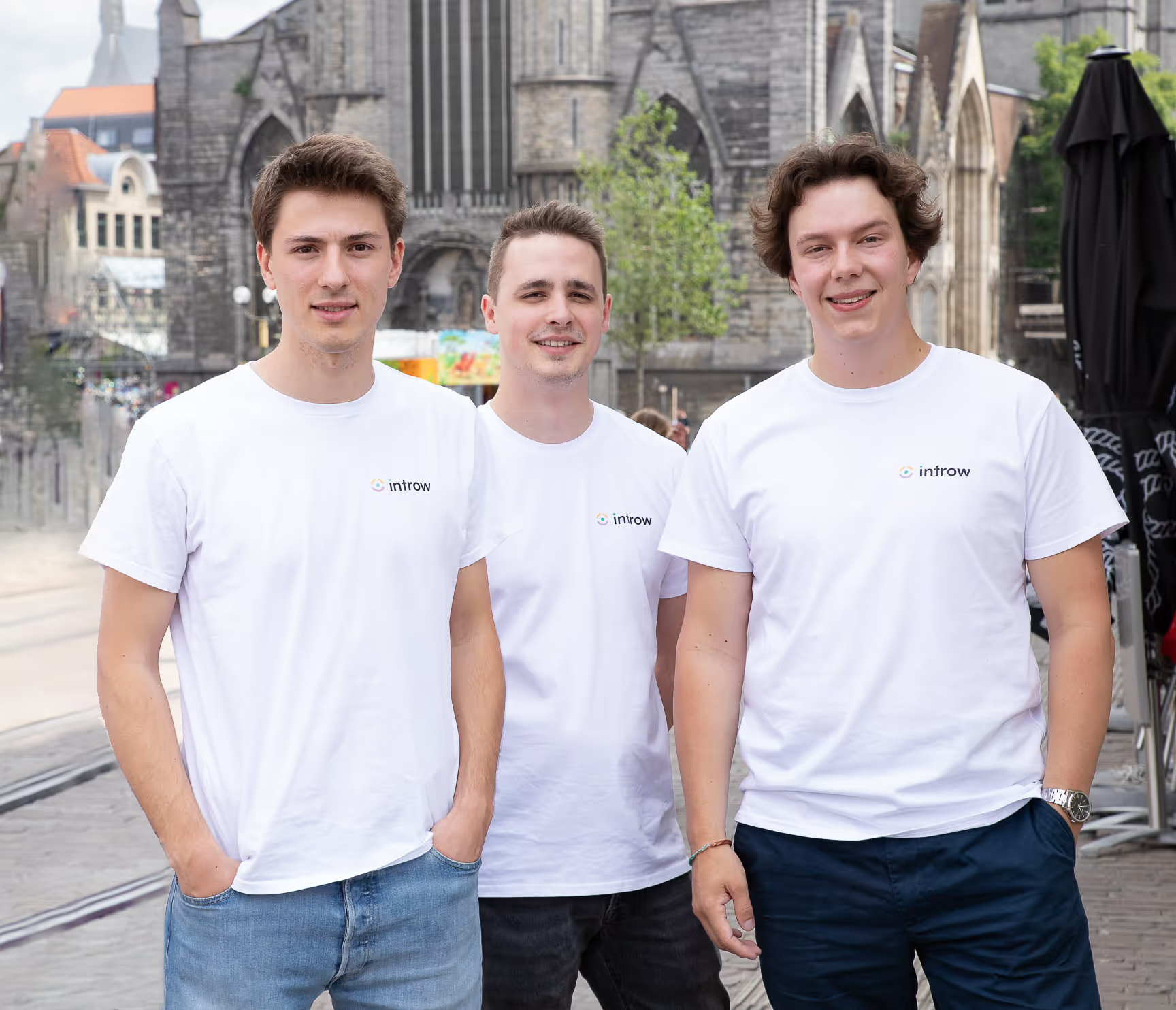
With the help and expertise of these experienced angel investors and Pitchdrive, Introw will use this funding to convert warm leads into deals worldwide. Introw is onboarding new users every day.
Sign ups are open at introw.io
Top 15 Impact Alternatives for Effective Partner Management in 2025
Impact is a partnership management platform designed primarily for affiliate, influencer, and performance marketing programs.
It can be a handy tool if your business relies heavily on affiliates and influencers to generate sales.
However, if your partner program is broader in scope – perhaps your strategy is more channel-focused, for example – you’ll benefit from a more comprehensive partner relationship management (PRM) platform.
Ready to kick your partner management up a gear this year? Read on for our 15 top Impact.com alternatives in 2025.
Why Consider an Impact Alternative in 2025?
An end-to-end performance marketing tool, Impact excels at affiliate and influencer programs because that’s what it’s designed for.
However, there are four major areas in which SaaS outstrips this online platform.
1. Limited CRM-Native Channel Workflows
Modern SaaS platforms like Introw work on top of your CRM, enabling seamless logging, tracking, and reporting directly inside Salesforce or HubSpot.
This deep embedding provides sales teams and all their partners with real-time visibility, eliminating the need to switch platforms.
However, Impact is browser and app-based, and requires teams and their partners to operate largely outside the CRM, which can create friction in channel workflows.
2. Deal Registration & Co-sell Motions Vs Affiliate Tracking
While Impact is certainly strong on affiliate tracking and commission management, it doesn’t fully support deal registration and co-sell motions.
Affiliate link tracking is primarily focused on click attribution, but SaaS functionality goes deeper, enabling joint selling motions, more meaningful collaboration, and improved pipeline visibility.
Indeed, try out a modern SaaS platform and you’ll generally find a structured deal registration pipeline, where partners can submit opportunities, collaborate with sales teams, and track progress through the funnel.
3. Off-portal engagement
Impact relies heavily on its portal for communication with partners.
In contrast, modern SaaS solutions meet partners where they already work – for example, email, Slack, or other collaboration tools.
What’s more, in 2025, this off-portal engagement is mostly automated, delivering updates surrounding deal stages, approvals, or payments into partners’ daily workflows.
And when it comes to saving time and boosting engagement, you can't beat automated outreach.
4. Attribution & Forecasting
Impact will track conversions and clicks, but SaaS platforms will typically offer more robust attribution and forecasting capabilities than this.
Indeed, SaaS tools directly tie partner activities to pipeline metrics, making it clear how each partner impacts revenue.
This makes strategic planning and forecasting much easier.
➡️ This is why, if your B2B partnerships include referral, reseller, or co-sell, it’s worth considering a CRM-first alternative to Impact. Learn more about Introw here, or read on for more information on shopping for the best alternative.
What to Look For in an Impact Alternative
Considering swapping Impact for a modern PRM?
Here’s what you should be looking for when it comes to choosing your next PRM.
- CRM-first: Look for a PRM that integrates directly with your CRM, so partner records, fields, and reporting live natively in Salesforce or HubSpot.
- Deal Registration & Co-sell: Your new PRM should support seamless deal registration and co-selling by enabling a shared pipeline, mutual action plans, and conflict prevention.
- Off-portal Engagement: Forcing partners to log into a portal every time they need a quick update will put you on a fast track to disengagement. Instead, prioritize a PRM that delivers automated updates and alerts in channels they already use, such as email or Slack.
- Automation: Automation is a must-have in 2025. These tools help you launch and optimize campaigns, onboard partners, engage partners, send activity reminders and prepare for QBRs much more quickly, and with much less manual labour, than in the past.
- Attribution: Make sure your new platform provides clear attribution, from partner engagement through to pipeline and revenue impact.
- Partner UX: Your PRM must deliver a frictionless experience, making the user journey as easy as possible for your partners. Look out for features like a simple submission process, easy access to branded assets, and self-serve tools.
- Scale & Security: As your partnership program grows, you’ll need to be able to easily manage different partner tiers, regions, and types. Choose a PRM with strong security and role-based access controls.
The 15 Best Impact Alternatives for SaaS Partner Programs (2025)
If you’ve been using Impact, but are keen to see what other alternatives could offer you, you’re in the right place.
Here’s our pick of the 15 best Impact alternatives on the market in 2025.
1) Introw
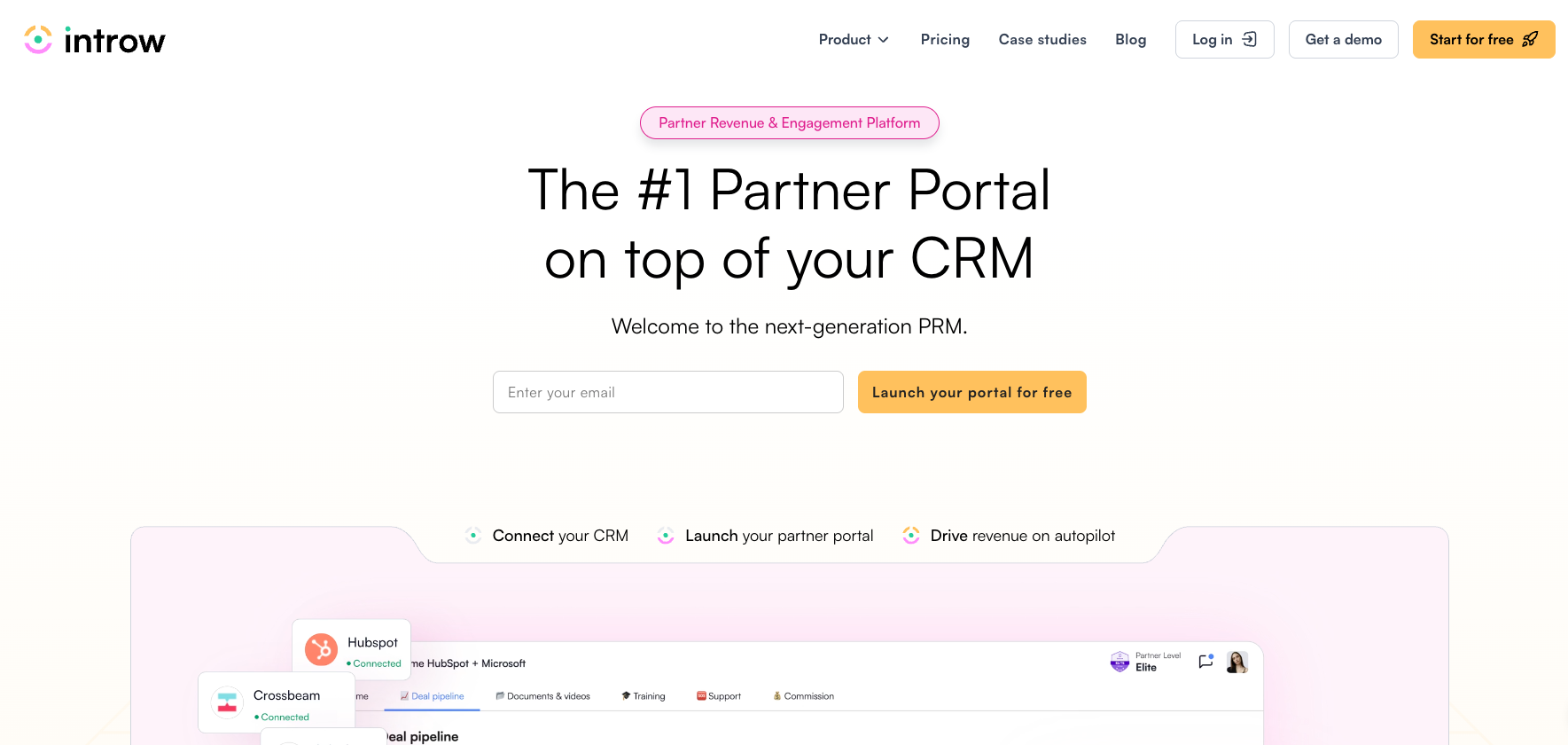
A CRM-first PRM designed for SaaS, Introw is perfect for teams that already use Salesforce or HubSpot, and are running referral, reseller, and/or co-sell programs at scale.
So, why should you choose Introw over Impact?
Introw is purpose-built for channel partnerships — with CRM-native, partner-first workflows that streamline co-selling and co-marketing across your ecosystem.
It embeds deal registration, co-sell updates, and engagement tracking directly inside your CRM, while off-portal updates via email and Slack keep partners engaged without forcing them to log into another tool.
Key capabilities:
- Campaign management features
- Partner engagement analytics (visits, content usage, opens/clicks)
- Outreach automation including automated deal updates
- White-labeled experiences
- Role-based dashboards
- Integrates with Salesforce, HubSpot, Slack
- Responsive customer support
🚀Ready to take your partner program to the next level? Request an Introw demo here.
2) PartnerStack
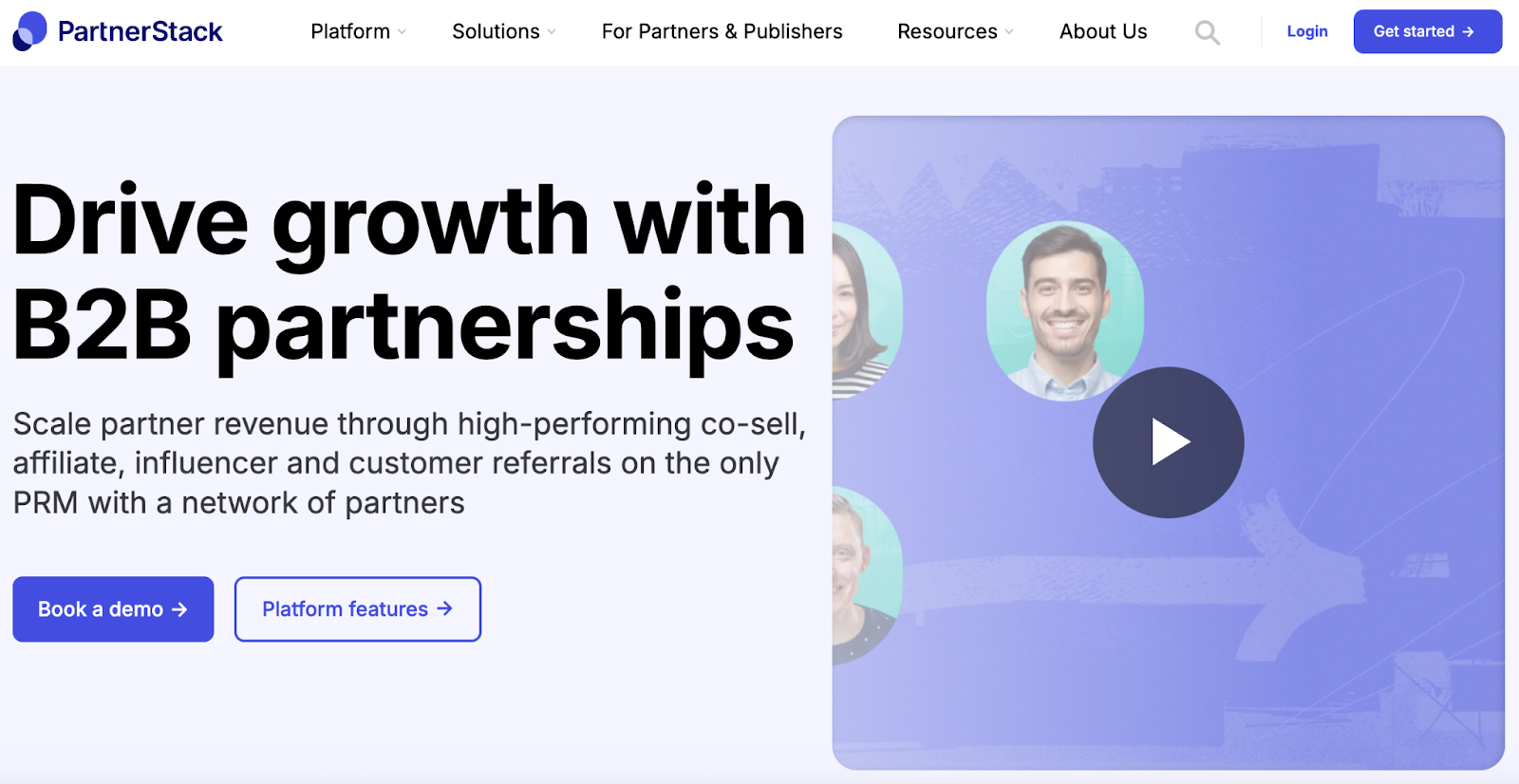
Looking to combine affiliate programs, referral marketing, and reseller partners while gaining marketplace reach?
Take a look at PartnerStack.
Unlike Impact, which is primarily affiliate-focused, PartnerStack is built with SaaS go-to-market strategies in mind and extends well beyond affiliate-only use cases.
Please note that PartnerStack is not CRM-native, so advanced co-sell programs may require additional tools.
Key capabilities:
- Partner marketplace
- Payouts
- Referrals/reseller workflows
💡Looking for some great PartnerStack alternatives? Here are some of the best.
3) Kiflo
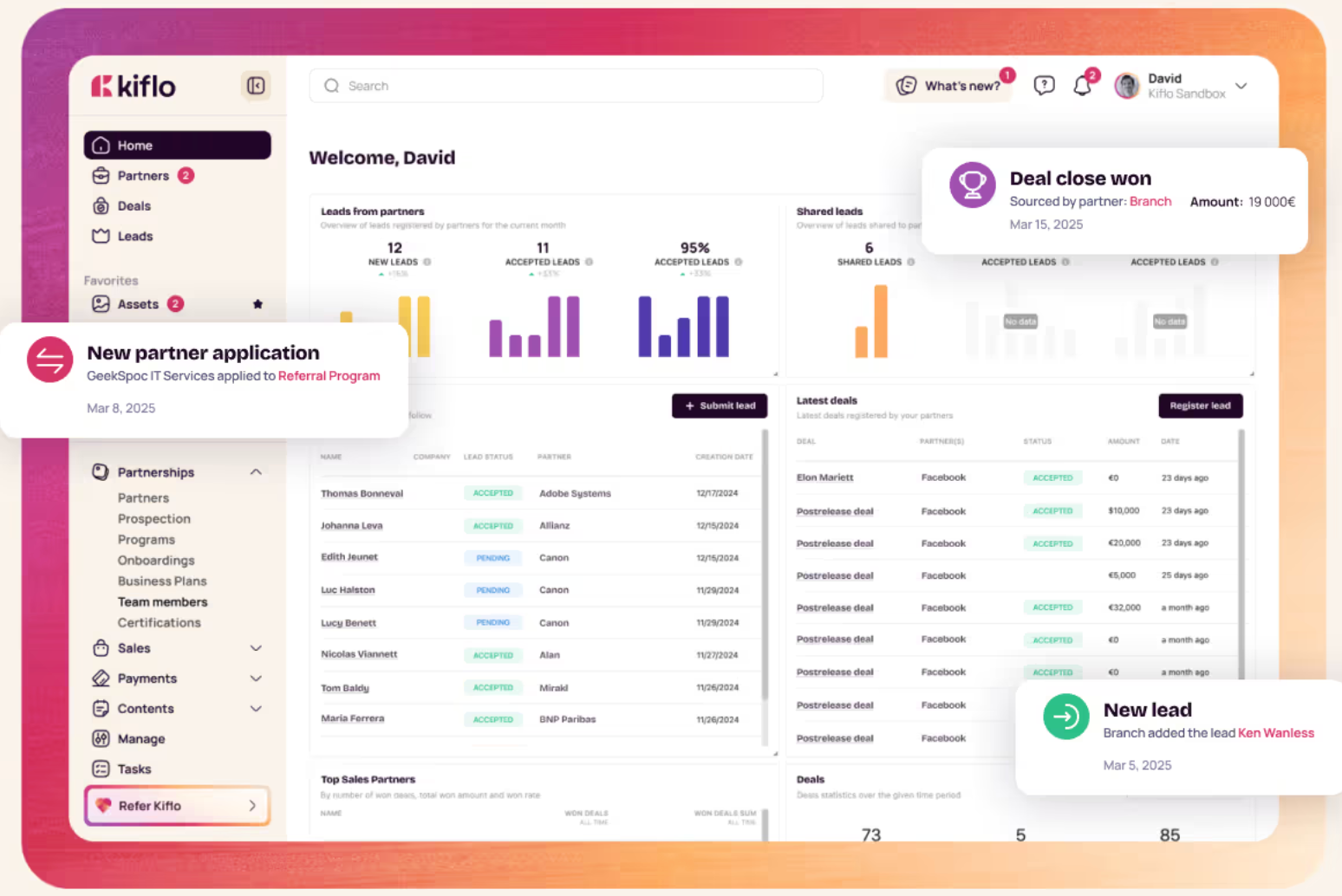
Kiflo is a PRM that works well for small to mid-market SaaS companies just starting their formal channel or partner programs.
This platform offers a lighter-weight PRM approach compared to Impact, making it easier for companies to launch and manage reseller or referral programs.
However, bear in mind that it has limited enterprise-grade analytics and deep CRM workflows, so it’s much better suited to smaller businesses looking for a simpler solution.
Key capabilities:
- Deal registration
- Incentives
- Enablement basics
➡️ You can see our top Kiflo alternatives here.
4) Channelscaler
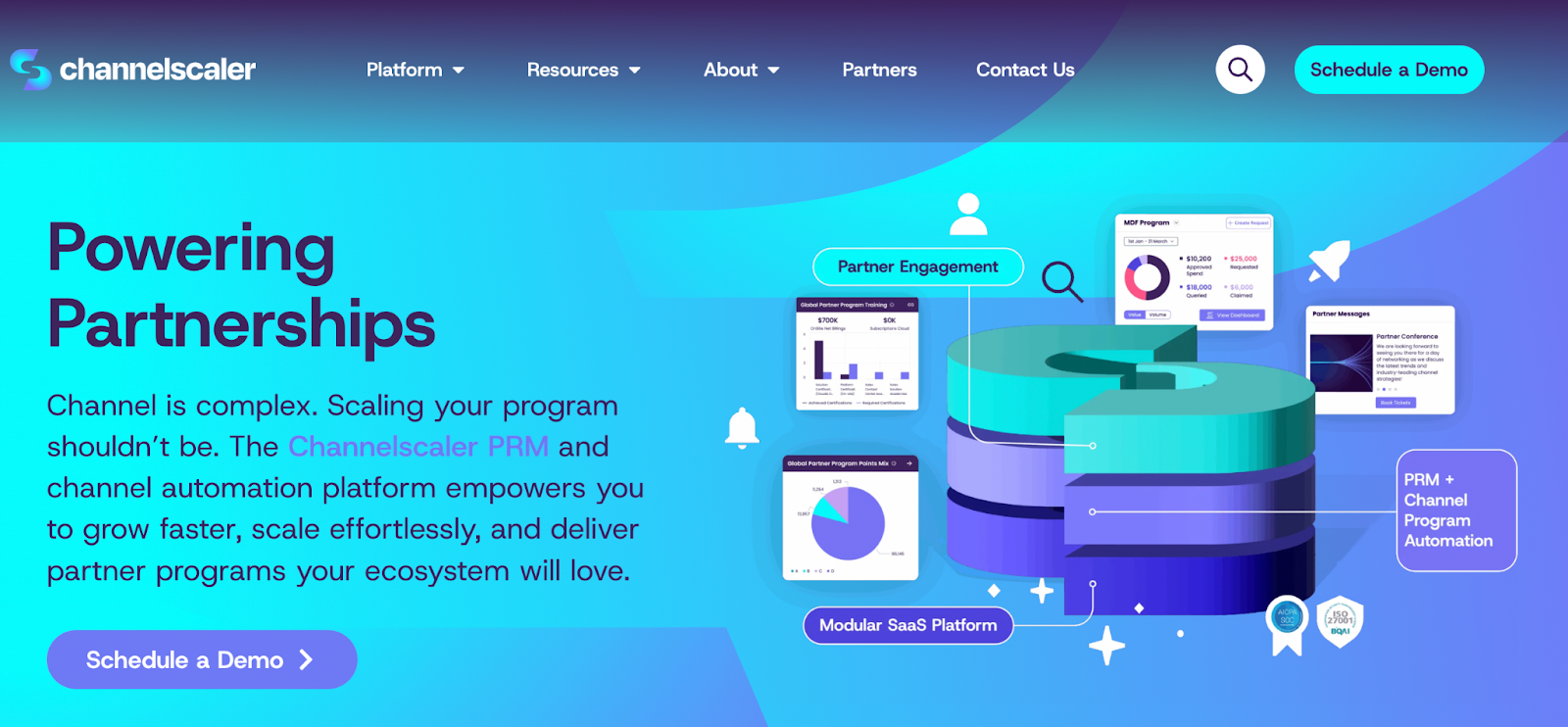
Channelscaler offers a full PRM and partner automation stack for companies running channel or partner programs.
It’s perfect for companies looking for modular solutions, but if you’re planning to run a simple program, be careful you don’t end up implementing more modules than you actually need.
How does it compare to Impact? Channelscaler delivers a channel-centric platform with a wider scope, while Impact is an affiliate-first tool.
Key capabilities:
- Deal registration
- Incentive and rebate management
- Content & enablement
- Partner journey automation
- Performance tracking dashboards
5) Impartner
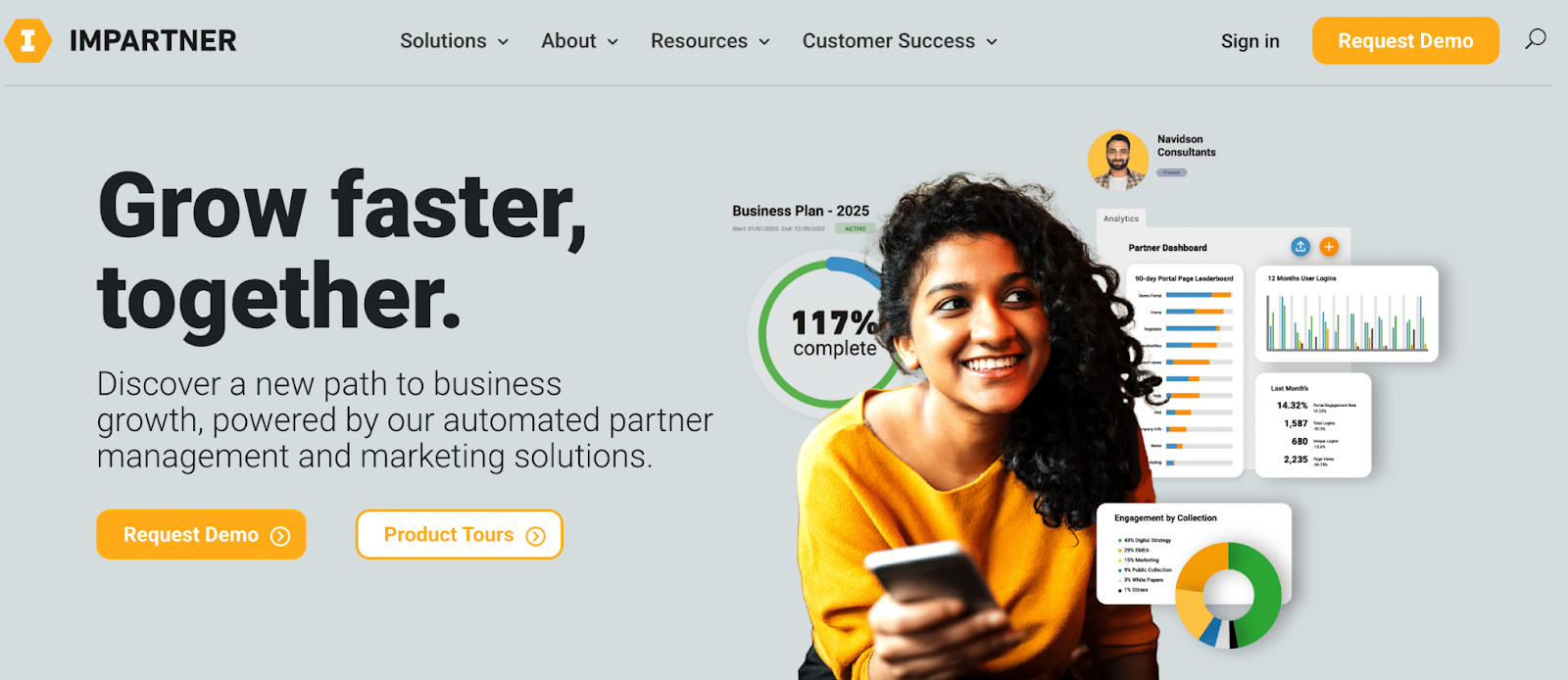
Partner marketing automation platform Impartner caters to enterprises with complex, global channel operations.
Consider this platform if you need a system robust enough to handle multiple regions, tiers, and partner types.
If you’re considering switching from Impact to Impartner, you’ll notice a huge difference: namely, that this solution provides a full-stack PRM built for deep governance and enterprise-grade scale, while Impact has a more narrow focus.
Of course, Impartner’s more complex system comes with a heavier implementation and administrative lift, so it’s vital to ensure your business has the resources to manage it effectively.
Key capabilities:
- Tiering
- MDF
- Workflows
- Robust analytics
6) Unifyr
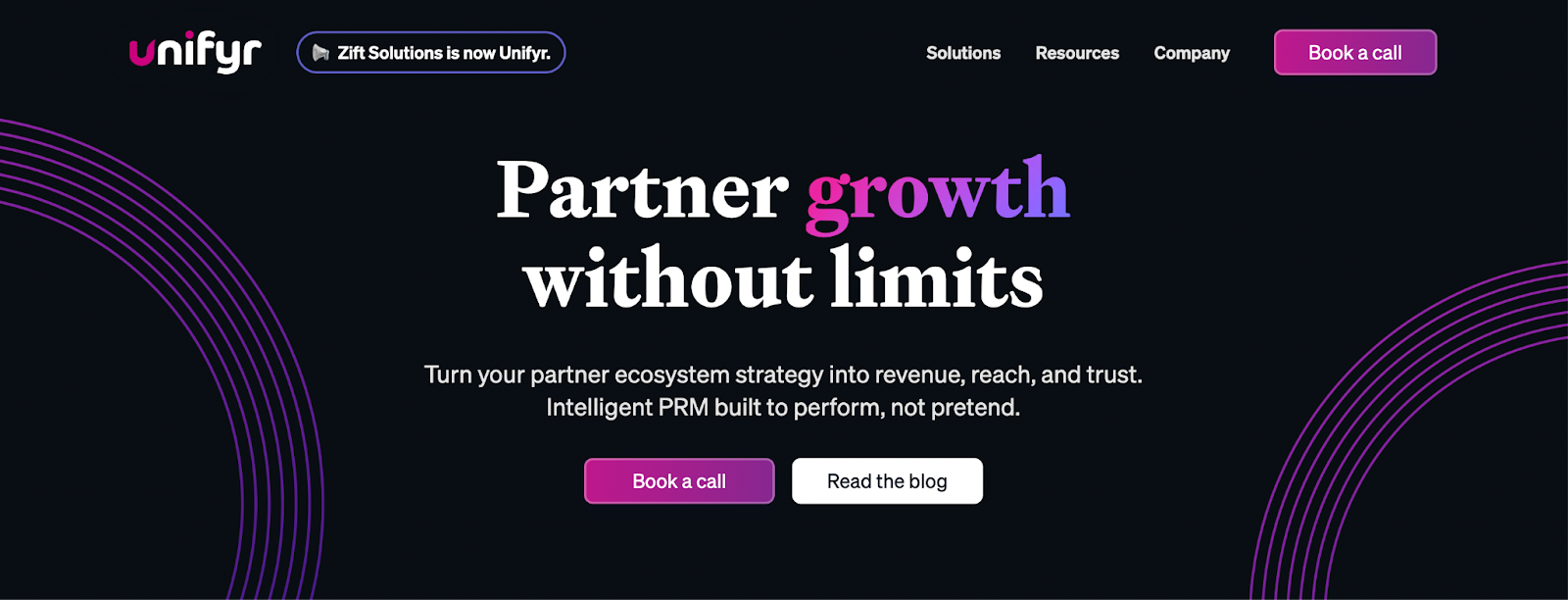
Unifyr is an all-in-one, AI-enabled PRM and channel growth platform.
It is designed for organizations managing partner ecosystems and aiming to centralize and streamline their operations, particularly in dealing with maturing or enterprise-scale channel programs.
This SaaS platform offers a wider variety of features than Impact, which focuses on performance marketing.
However, this does mean there can be a learning curve and it can be a little heavy for smaller brands, with some advanced features more applicable to mid-size or large companies.
Key capabilities:
- Partner onboarding & activation
- Deal registration & lead management
- Supplier/multi-vendor support
- AI-enabled features
7) Magentrix
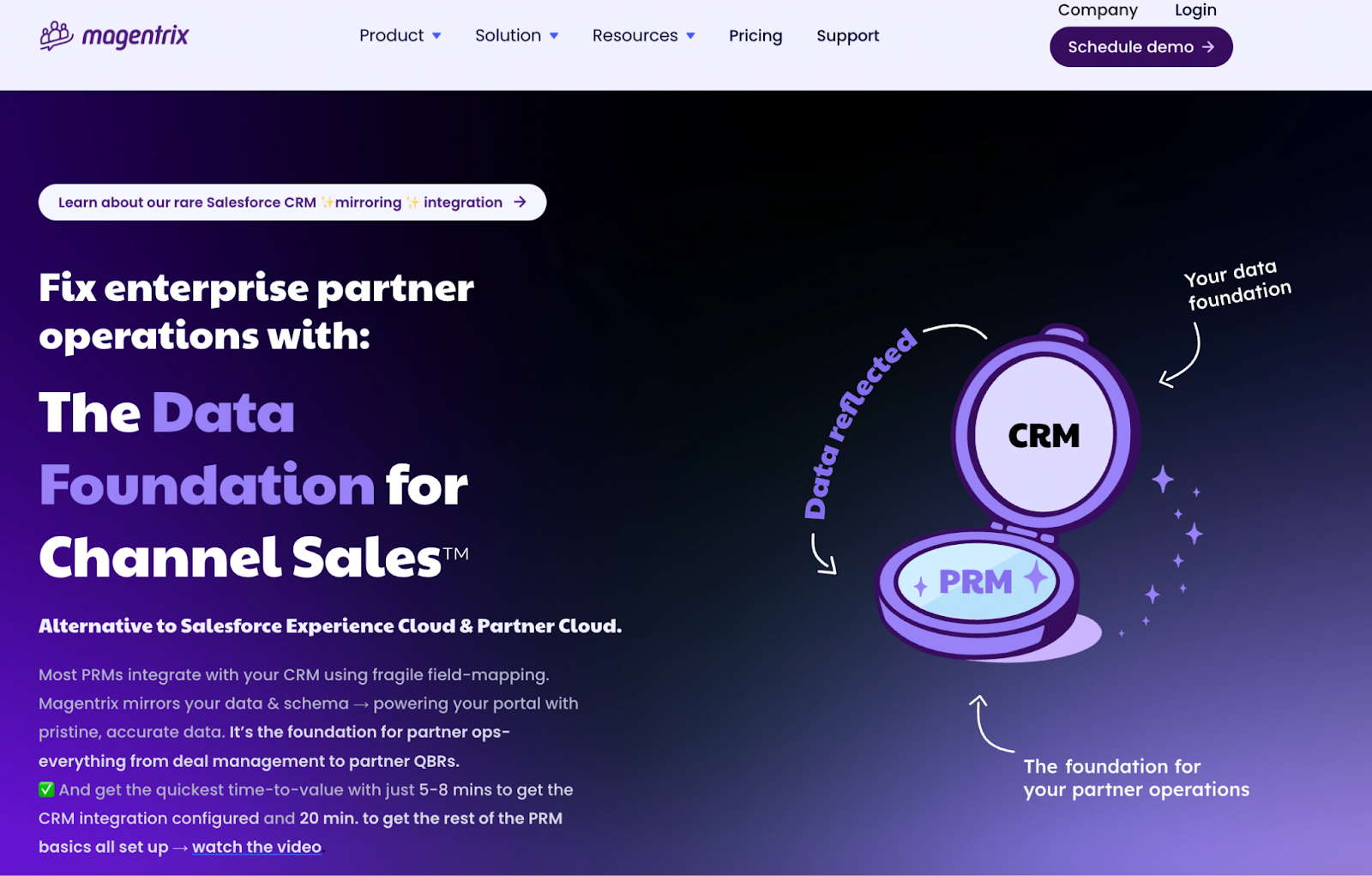
Magentrix is made for Salesforce-centric teams that need deeply integrated custom portals.
It’s a good match for teams that require close alignment between their CRM and the partner-facing portal, as well as powerful customization and scalability.
When compared to Impact, it’s worth noting that Magentrix offers deep Salesforce alignment, along with robust community and portal features that go beyond what the other platform provides.
However, since Magentrix is portal-first, it’s important to ensure that partner engagement does not rely solely on logging in.
Key capabilities:
- Resource library
- Case collaboration
- Portal UX
8) Channeltivity
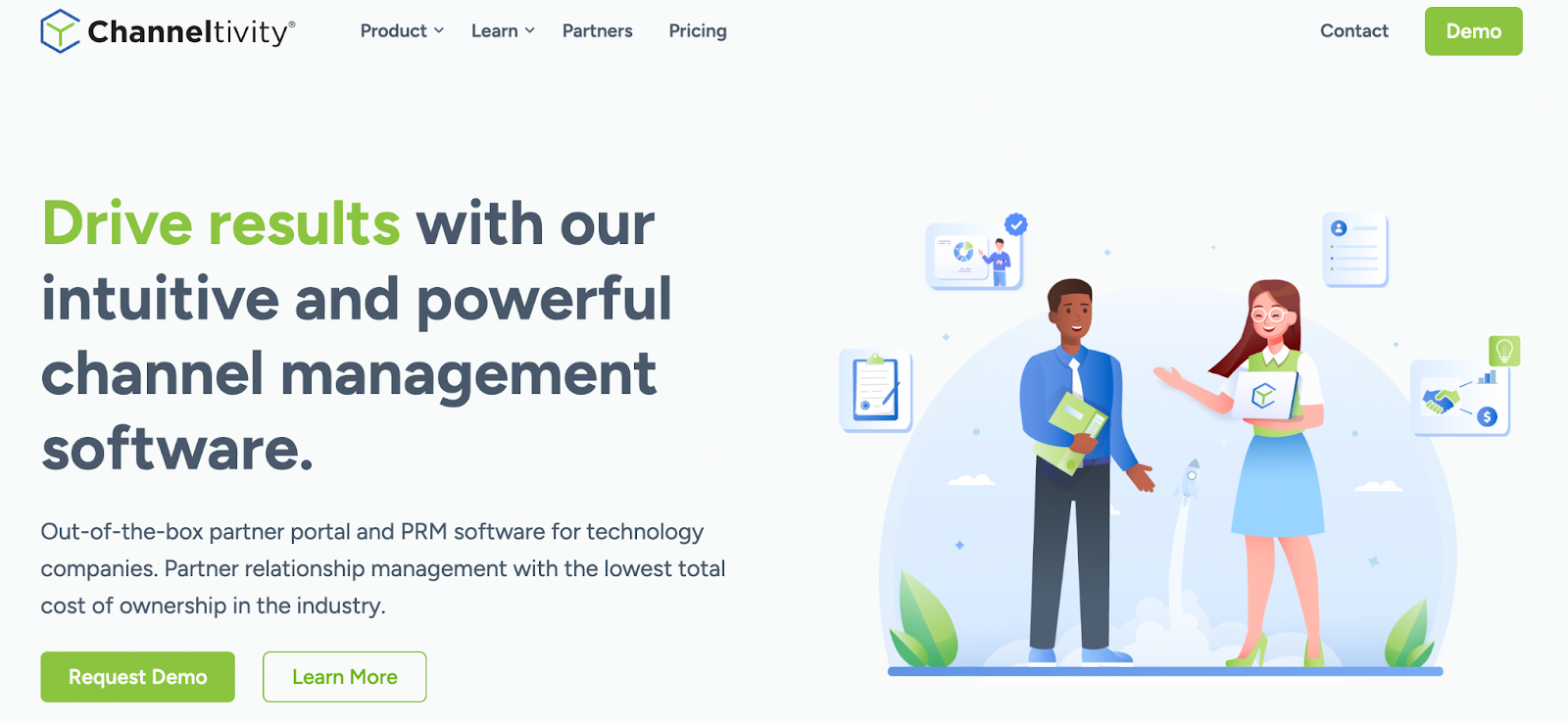
Channeltivity is designed for mid-market SaaS companies that need a comprehensive PRM to effectively manage and scale their channel programs.
This SaaS tool offers a solid foundation for channel operations, while Impact is more focused on affiliate programs.
For example, Channeltivity offers robust features, including deal registration, Market Development Fund management, and detailed reporting.
Just bear in mind that Channeltivity is primarily portal-centric, which could limit off-portal engagement.
Key capabilities:
- Partner onboarding
- Tiering
- Approvals
9) WorkSpan

Are you tasked with managing alliance and co-sell ecosystems?
WorkSpan facilitates collaboration between multiple partners on shared opportunities and joint sales initiatives.
This solution stands out over Impact because it’s built to manage joint pipelines across partners, which helps partners to coordinate sales efforts more effectively than an affiliate-focused platform like Impact.
However, WorkSpan is not a full PRM – it’s typically used alongside a PRM or CRM to enhance partner management.
Key capabilities:
- Co-sell workflows
- Joint planning
- Pipeline tracking
10) Partnerize
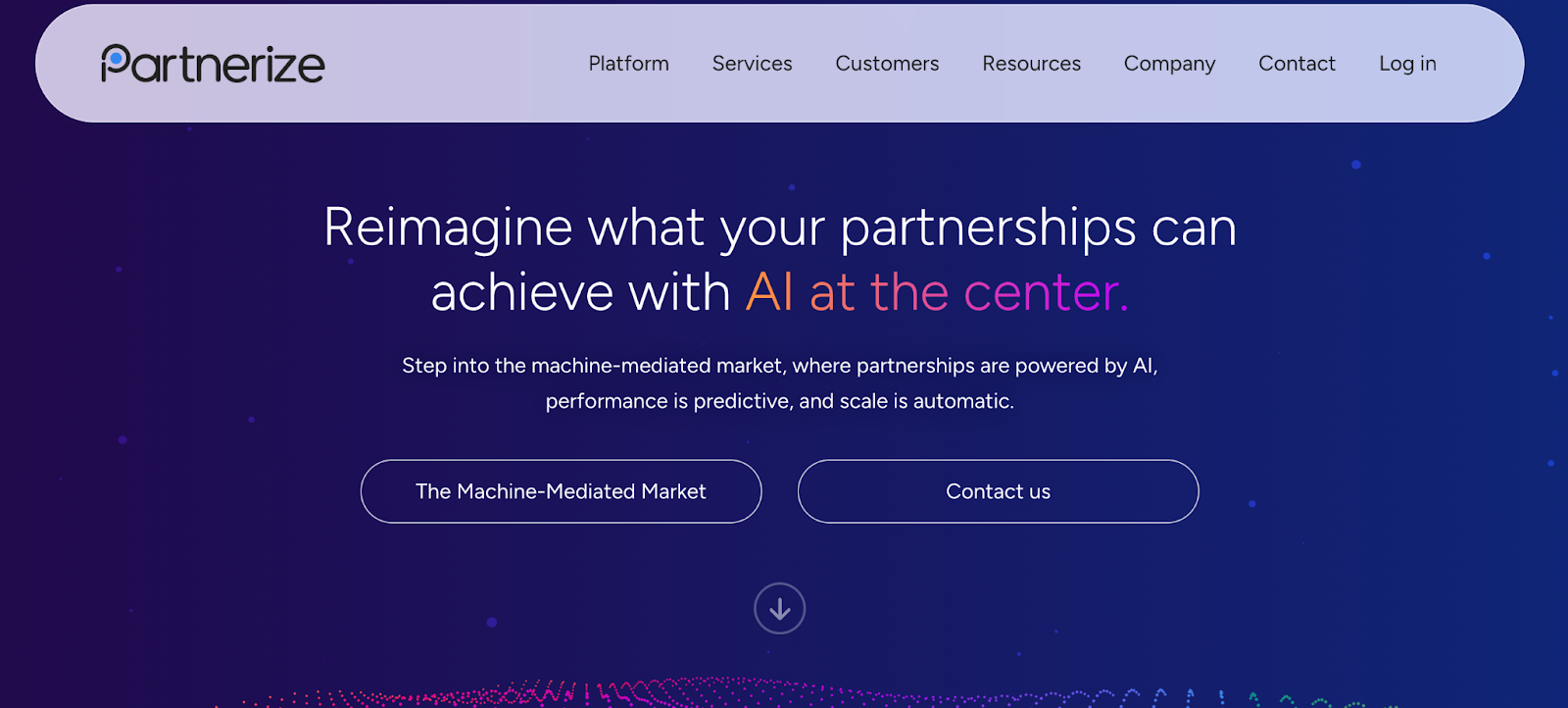
This one has an enterprise focus.
Partnerize provides a single platform for diverse partner types, making it particularly useful for those who manage both affiliate programs and broader partnership initiatives.
This platform supports a much wider range of partner types than Impact and provides robust optimization tools.
However, Partnerize does have a strong e-commerce and affiliate focus.
This means that if you’re looking for a B2B partnership solution, it’s vital to consider whether this platform caters best to your specific requirements.
Key capabilities:
- Contracting
- Payouts
- Advanced analytics features
11) TUNE
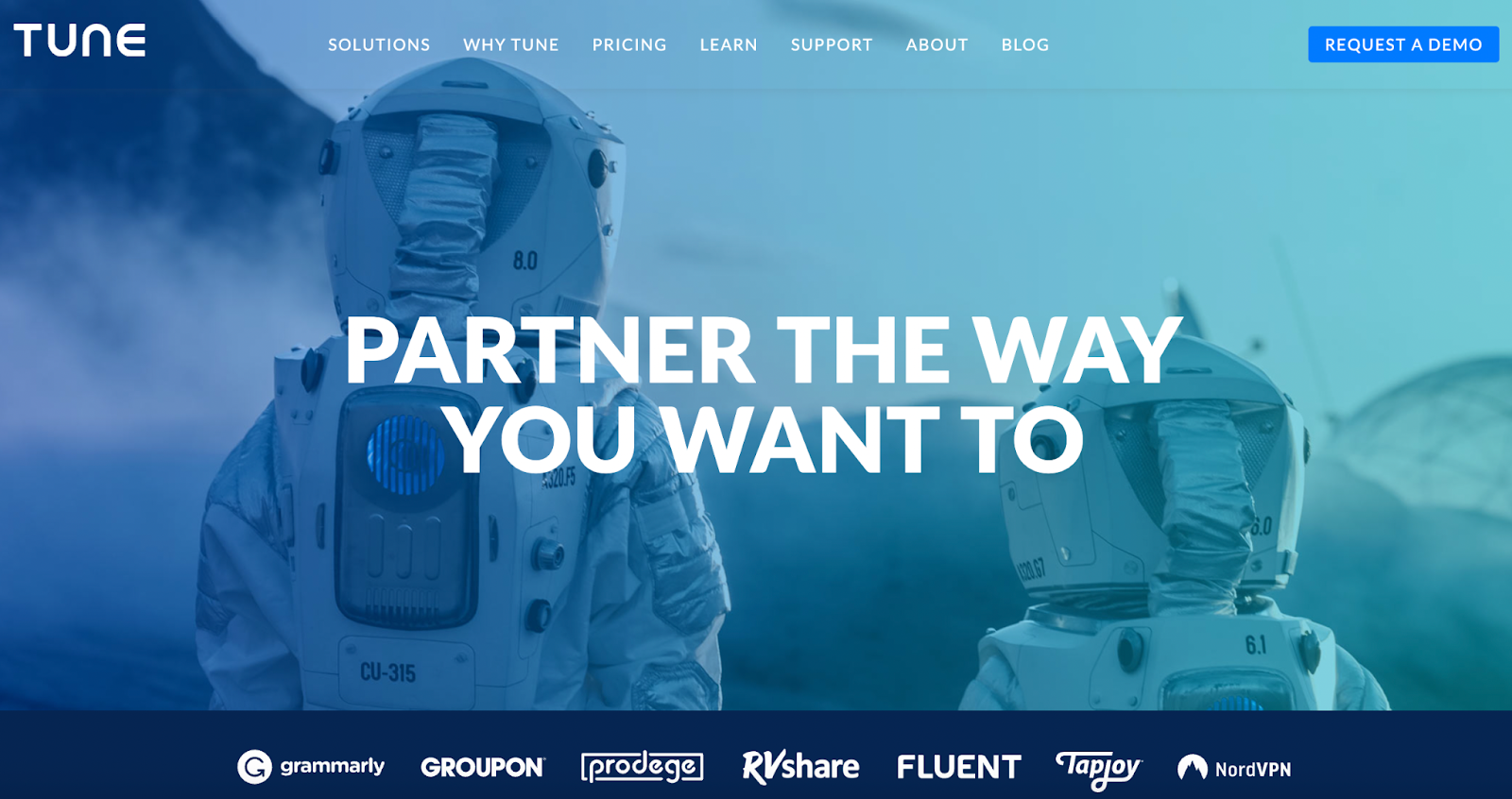
TUNE is designed for performance and affiliate marketing teams – especially those focused on mobile and app-based campaigns.
Businesses might pick this platform over Impact because of its flexible tracking capabilities and developer-friendly tools, which offer plenty of customization for technical integrations.
It’s important to note that TUNE is not built for B2B channel or co-sell programs.
This means while the platform might be useful for affiliate-focused retail brands aiming for ecommerce sales, it may not meet the needs of organizations looking to manage complex partner ecosystems beyond performance marketing channels.
Key capabilities:
- Custom tracking
- APIs
- Mobile SDKs
12) Affise
Built with affiliate networks and performance marketing in mind, Affise helps teams to streamline their operations and manage multiple affiliate performance programs efficiently.
While there’s overlap between Affise and Impact, Affise offers a more streamlined approach to affiliate operations and automated affiliate payouts.
Please note that Affise offers limited support for channel co-sell workflows, so it may not be suitable for organizations looking to manage broader B2B partner ecosystems.
Key capabilities:
- Tracking
- Fraud tools
- Program management
13) Everflow
Everflow is designed for performance and affiliate programs, especially those that demand comprehensive analytics and reporting capabilities from their partner marketing platform.
Indeed, this tech offers an alternative tracking stack to Impact, with flexible reporting and detailed analytics.
Keep in mind that Everflow is primarily affiliate-focused and offers limited support for CRM-native channel operations.
So think carefully about whether it’s suitable for complex B2B co-sell programs.
Key capabilities:
- Partner tracking
- Fraud prevention
- APIs
👉Discover some top Everflow alternatives here.
14) Salesforce PRM
Already work on Salesforce? Opting for Salesforce PRM could make your team’s life a lot easier.
Salesforce PRM is designed for teams that want their partner management fully integrated within their CRM – and it’s a very different solution to Impact.
Indeed, Salesforce PRM offers native Salesforce records, reporting, and extensibility, making it a strong choice for organizations that need a deeply integrated solution rather than an external affiliate-focused platform.
It’s worth noting that the out-of-the-box user experience is pretty basic, so the success of Salesforce PRM often depends on internal resources and technical assistance.
Or, in other words, how well you’re able to customize and optimize the system for your partner programs.
Key features:
- Partner accounts
- Deal reg
- Workflows
15) HubSpot + PRM Add-Ons
Looking for tailored solutions?
HubSpot-led go-to-market teams may decide to stick with their CRM and invest in some PRM add-ons.
By simply extending their CRM to manage partner programs, these teams can work with CRM-native performance data while selecting the partner extensions that best serve their purposes.
However, there are downsides to this approach.
Indeed, for organizations that need deeper PRM functionality, a dedicated PRM platform like Introw will be required.
HubSpot supports:
- Objects
- Workflows
- Partner tagging
- Reporting
Why SaaS Teams Pick Introw Over Impact
Introw is a very different solution to Impact, but if you’re looking for a PRM that supports SaaS partner management, it’s a powerful alternative.
Here’s why SaaS teams benefit from choosing Introw:
- Channel-first, not affiliate-first: Impact was designed for affiliate management and influencer programs, so its workflows revolve around clicks, payouts, and referral tracking. But Introw is purpose-built for SaaS, making deal registration, co-selling, and partner engagement its core focus.
- CRM-native: With Introw, all partner activity lives directly inside Salesforce or HubSpot, eliminating silos and giving you a single source of truth.
- Off-portal engagement: Many PRMs rely on portals that require logins. This adds friction to the partner journey and limits engagement. Introw meets partners where they work (such as email or Slack) for seamless collaboration.
- Automation everywhere: Eliminate tedious administrative tasks with Introw, and spend your time adding genuine value. Introw automates onboarding, campaign management, nudges, and even QBR prep.
- Attribution you can trust: Affiliate-first tools typically track clicks and last-touch referrals, which don’t accurately reflect the influence of SaaS partners. Introw ties content usage, notifications, and partner activity directly to pipeline and revenue for attribution you can feel confident in.
📣 Want to see Introw in action? Request a demo here.
Conclusion
Is it time to seek alternatives to Impact?
You’ll know when you’ve found the right Impact alternative for B2B SaaS, because it will improve co-selling, engagement, and attribution directly in your CRM.
When shopping around for Impact.com alternatives, take a step back to review how your current partner program works.
Consider whether your channel strategy is as effective as you’d like it to be, and identify any gaps.
Then:
1️⃣ Shortlist CRM-first PRMs
2️⃣ Run a live pilot
3️⃣ Choose the platform your partners actually respond to
👉 See how Introw can power your partner program – book a demo today.
B2B Partnerships 101: Strategies for Success in 2026
In 2026, B2B partnerships will be more crucial than ever as SaaS brands strive for robust business growth while reducing costs.
As SaaS companies have increasingly relied on partnerships over the past few years, their strategies have evolved, transforming basic ad hoc collaborations into complex ecosystems made up of complementary products and services.
So what exactly do B2B partnerships in SaaS look like today? And how can you ensure they have maximum impact?
Read on for our 15 strategies for SaaS partnership success in 2026.
What Are B2B Partnerships?
At their core, B2B partnerships are collaborative, revenue-oriented relationships between different businesses.
Generally, these partner companies will operate in different but complementary spaces, and they may team up for a specific function, such as distribution, marketing, product/tech, or services.
B2B partnerships are a particularly popular option in the SaaS sector, as they help software companies expand their pipelines, increase product value through integrations and bundled offerings, lower CAC by leveraging partners’ reach, and close deals faster.
An important distinction to understand is the difference between B2B partnerships, channel partnership programs, and ecosystems.
Bear in mind that, although each of the three models below is distinct, there is significant overlap.
- A B2B partnership is any collaborative relationship formed to drive shared revenue or value.
- A channel partner program is a formal, structured way of managing and scaling B2B partnerships. Often, these use tiers, incentives, and certifications.
- An ecosystem is a broad network involving many different partners in various disciplines. All these partners work together to create value for customers.
Why B2B Partnerships Will Matter More Than Ever in 2026
In 2026, partnerships are a growth engine, not a side channel.
With budgets under pressure, SaaS businesses are increasingly relying on their partnerships to drive growth while simultaneously reducing their spending.
Furthermore, buyers now expect more than stand-alone products. They want integrations, services, and bundled solutions that address larger problems – all of which can be delivered through partnerships.
Meanwhile, go-to-market has shifted toward ecosystem-led growth, where companies move with partners from co-marketing to co-sell to co-success, driving not just new business but retention and expansion.
And because the CRM is the system of record, attribution must live there, or partner impact goes unmeasured.
Types & Models of B2B Partnerships
So let’s take a look at the different types of B2B partnerships you’re likely to see in 2026.
- Marketing partnerships, including co-marketing, content creation, webinars, events, and lead generation swaps.
- Distribution partnerships, like reseller, VAR, MSP, referral, and marketplaces.
- Product/Tech partnerships, including integrations, ISVs, OEMs, and solution bundles.
- Services/SIs/Agencies, such as implementation, migration, and vertical packages.
There are also different ways to structure partner relationships.
Here are some of the most common models:
- Transactional partners bring in occasional leads or deals
- Strategic partners are more aligned with shared goals, engage in joint planning, and make long-term commitments.
- Tiered programs reward partners based on volume or certification
- Ecosystem models focus on collaboration across numerous partner types
- Co-sell frameworks see direct collaboration between AEs from both companies to close deals together
For example, you might have an integration and reseller bundle that combines a SaaS integration with a reseller offering it as a packaged deal.
An SI package for a vertical could look like a systems integrator designing a tailored solution, which includes your product, for an industry like healthcare or finance.
Or perhaps you’ll develop a co-marketing → co-sell funnel? You can build this by running joint marketing campaigns with your partners and then moving qualified leads into joint sales motions in order to close.
15 Strategies for B2B Partnership Success in 2026
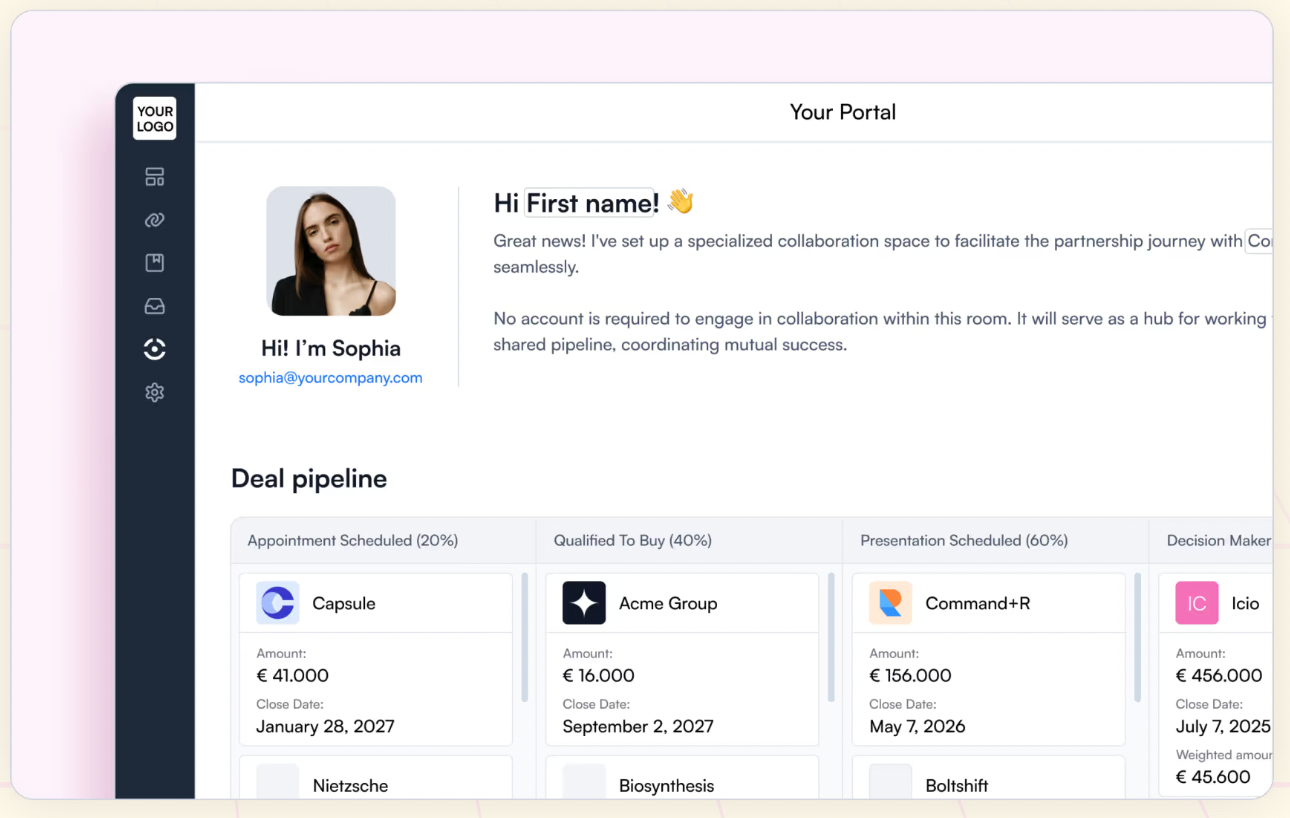
Is it time to elevate your SaaS partnership program to the next level?
Here are 15 B2B partnership strategies for success in 2026.
1. Define Your Partner ICP
Ready to find your ideal partner?
Just like you build an Ideal Customer Profile when you start your business, partnership success kicks off with a clear partner ICP.
This should help establish a clear B2B partnership strategy, identify potential partners to prioritise, and avoid chasing ‘logo value’ over the actual revenue impact each partner could offer.
Actions
Begin by identifying which partner characteristics most closely align with your product and target customers.
Consider the following.
- Which industries do they operate in?
- What kind of deal sizes are they working with?
- Where are they geographically?
- Do you have any tech stack overlaps?
Then, build a partner fit score that prioritises ensuring you share a very similar ICP, as well as market reach, and how complementary your SaaS products are.
How Can Introw Help?
Use partner relationship management (PRM) platform Introw to segment partners and automate scoring based on their performance and engagement.
2. Craft a Clear Mutual Value Proposition (MVP)
What problem do you solve together? Why now? Why you two?
Every strong partnership revolves around a shared story of why the partners have better outcomes together.
Having this clarity makes it easier to align sales teams and resonate with customers.
Actions
When considering a new partnership, start by defining your joint problem.
Why are you best positioned to overcome this when working together?
Why is this an urgent problem that needs to be solved now?
Why is your combined approach to solving this problem unique?
Use your answers to craft a concise one-pager that lays out your MVP and includes ROI proof.
Finally, develop a joint demo narrative that showcases your solution in action.
How Can Introw Help?
With Introw, teams can keep their co-sell playbooks all in one centralized location.
This makes it much easier to track which content partners are actually using (and using successfully) to drive deals.
3. Design Motion-Specific Onboarding
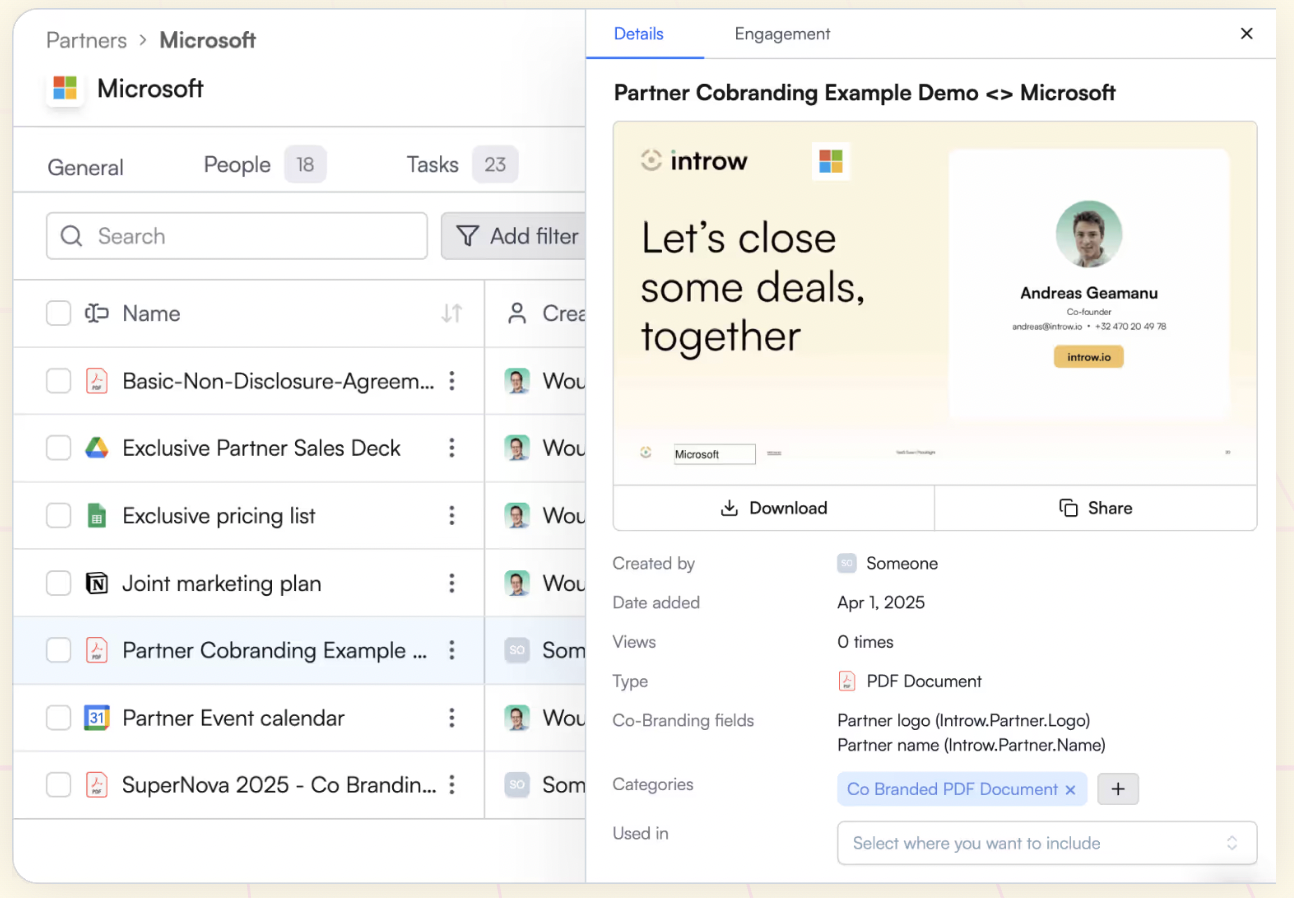
Not all B2B SaaS partnerships operate in the same way.
Referral, reseller, and integration partnerships, for example, each have their own unique roles and requirements.
This is why it’s vital to avoid taking a one-size-fits-all approach.
Actions
Instead, design motion-specific onboarding programs, complete with tailored templates, 30-60-90 day enablement plans, customized training, and clear first-deal targets to guide partners toward success.
This ensures partners know what success looks like for them and have realistic goals to work towards, helping them ramp up more quickly.
How Can Introw Help?
Tailoring your onboarding program to each partner may sound time-consuming, but with Introw, it doesn’t need to be.
Indeed, this sophisticated platform can automate onboarding flows, track completion, and manage certification progress.
This empowers your team to scale partner enablement efficiently, while maintaining high-quality engagement across various partnership types through tailored programs.
4. Automate First-30-Days Engagement
The first month of a partnership is absolutely crucial.
After all, partners who take early action are far more likely to deliver long-term value: you can look at speed-to-first-activity as an indicator of lifetime value.
Actions
To accelerate speed-to-first-activity without the time-sink of manual admin, automate partner engagement to cover their first 30 days with you.
Look at:
- Automating welcome sequences
- Drip key resources over time
- Send nudges (for example, “how to register your first deal”) to encourage and guide initial activity
How Can Introw Help?
Introw helps by delivering updates via email or Slack without requiring a portal login, ensuring you can reach new partners where they’re at.
The platform also provides engagement analytics, allowing teams to track who is active, identify stalled partners, and intervene at the first sign of disengagement.
5. Make Deal/lead Registration Frictionless
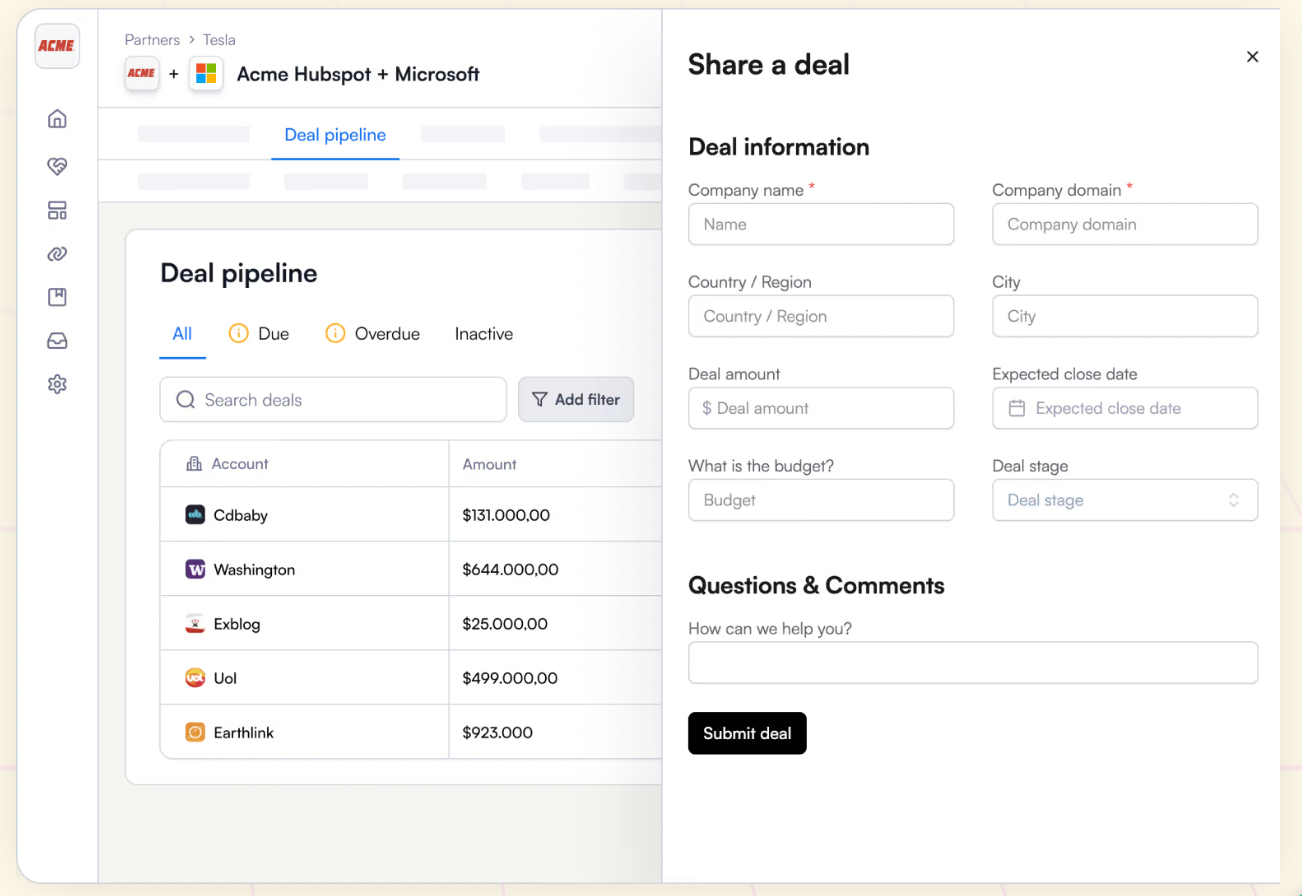
Remove any barriers to deal registration – essentially make it as quick and easy as possible – and you should find that your partners log their deals more quickly and accurately, accelerating the sales cycle.
Actions
The first step towards frictionless deal or lead registration is to avoid forcing portal logins.
Instead, enable submissions via CRM, links, email, or Slack.
This removes the potential barriers of forgotten passwords,
When setting up your deal/lead registration forms, it’s vital to use standardized fields across all your platforms to ensure you’re capturing consistent data.
You should also set up conflict rules to prevent overlapping data, and further smooth the partner journey with instant confirmations that submissions have been received.
How Can Introw Help?
Introw offers CRM-native deal/lead registration, which is crucial for this step.
It automatically syncs information and sends notifications to both internal teams and partners.
As outlined above, the platform also allows deal/lead reg links, email, or Slack.
6. Operationalize Co-Selling
Structured collaboration between your team and your partners is crucial for effective co-selling.
Set up a robust co-selling infrastructure, and you can ensure accountability, cut miscommunication, and synchronize both internal and partner teams.
The result?
The ability to close more joint deals more efficiently.
Actions
To operationalize co-selling, work through the following points together:
- Align on joint qualification criteria: The list of standards that your team and your partner use to determine whether a lead or opportunity is worth pursuing together.
- Set service-level agreements: Outline your clear expectations for how quickly and reliably teams must share information around a deal.
- Define Mutual Action Plans (MAPs): This shared roadmap should outline the key steps, responsibilities, and timelines required to close a deal.
- Standardize stage definitions: If you’ve worked in more than one organization, you’ll likely be aware that sales cycle stages can be defined differently from sales team to sales team. Co-selling demands that you agree on what each stage of the sales process actually represents for both your internal team and your partner team.
- Establish clear workflows between account executives: How will your internal sales team and your partner’s sales team collaborate on shared opportunities?
- Establish a process for note sharing: Where will notes be stored? Who is responsible for taking them? Who will they be shared with? Can readers comment on notes and how?
- Meeting support: What exactly will the partners involved expect from each other in client meetings? Will you create joint demos or presentations, help to guide discussions, or simply attend to answer product or technical questions?
How Can Introw Help?
When it comes to co-selling, Introw provides a considerable boost.
This software enables seamless coordination between your company and your partners by enabling shared updates visible to both teams, and tracking MAP milestones in real time.
It also supports co-marketing efforts through a shared asset library, making it easy for both internal teams and partners to access the latest pitch decks, one-pagers, and campaigns — all auto-synced and accessible without needing to log into a portal.
7. Build a Co-Marketing → Co-Sell Ladder
B2B SaaS partnerships come into their own when they progress from shared visibility to shared revenue.
To turn this into a reality, you must construct an effective co-marketing → co-sell ladder.
This ladder should start with co-marketing campaigns to build awareness, then nurture interest into MQLs, followed by warm partner-led introductions that convert into qualified opportunities, and finally, closed deals.
Actions
Of course, this ladder must be carefully managed.
First, you’ll need to create a shared campaign calendar to ensure all stakeholders are aware of their responsibilities and deadlines.
Next, enforce UTM tracking, so you can see exactly which partner, campaign, or channel drove a lead or deal.
Finally, equip your SDRs with tailored enablement content.
How Can Introw Help?
With Introw, you can seamlessly manage co-marketing logistics such as campaign announcements.
The platform also makes tracking your co-marketing and co-sell activities easy, with visibility into partner-specific engagement like clicks and opens. Plus, you can centrally manage and distribute co-branded materials — including blog posts, one-pagers, and pitch decks — making it simple for partners to acc
8. Segment Partners and Personalize Cadence
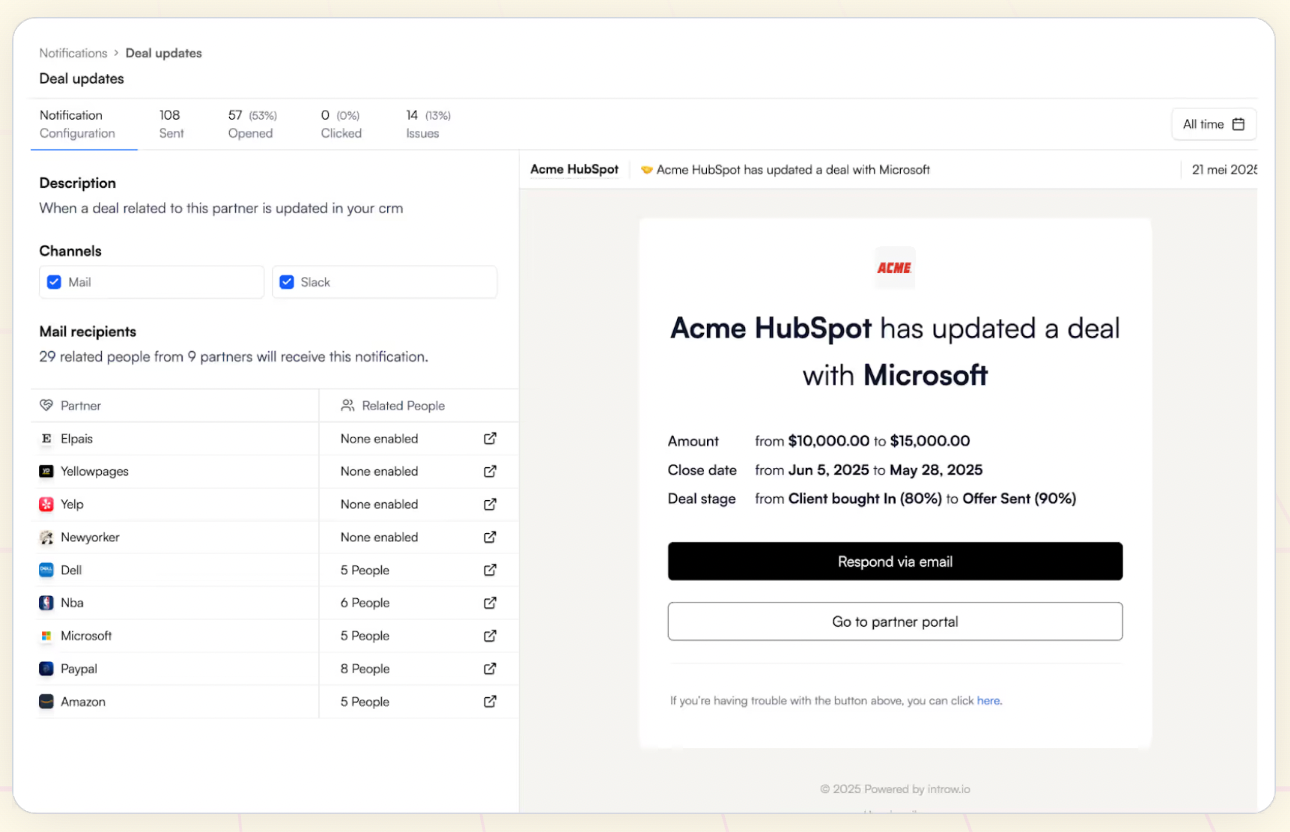
In a true partner ecosystem, you’ll have some companies that contribute to your program daily, and others that just pop in as and when they have a lead for you.
It’s important not to treat all of these partners in the same way for two reasons.
Firstly, treating every partner as if they contribute equally will dilute your results.
Furthermore, partners will respond best to tailored outreach cadence and bespoke engagement.
Part of getting this right is about matching your partners’ maturity level within your scheme.
Actions
Start by tiering partners based on their potential (for example, market fit, shared ICP, deal size) and engagement (for example, their activity and responsiveness).
Then, tailor your outreach cadence and messaging to speak to these tiers.
For example, run a ‘Top 20%’ play for high-potential partners with frequent check-ins and co-selling support, while using re-engagement flows to revive dormant partners.
How Can Introw Help?
Not too long ago, personalization was an extremely time-consuming (but still necessary) practice.
However, Introw makes personalization scalable, with dynamic partner segments and automated cadences per tier, ensuring every partner gets the right level of attention at the right time – and without all the tedious admin.
9. Enable Partner Sellers (Not Just Marketers)
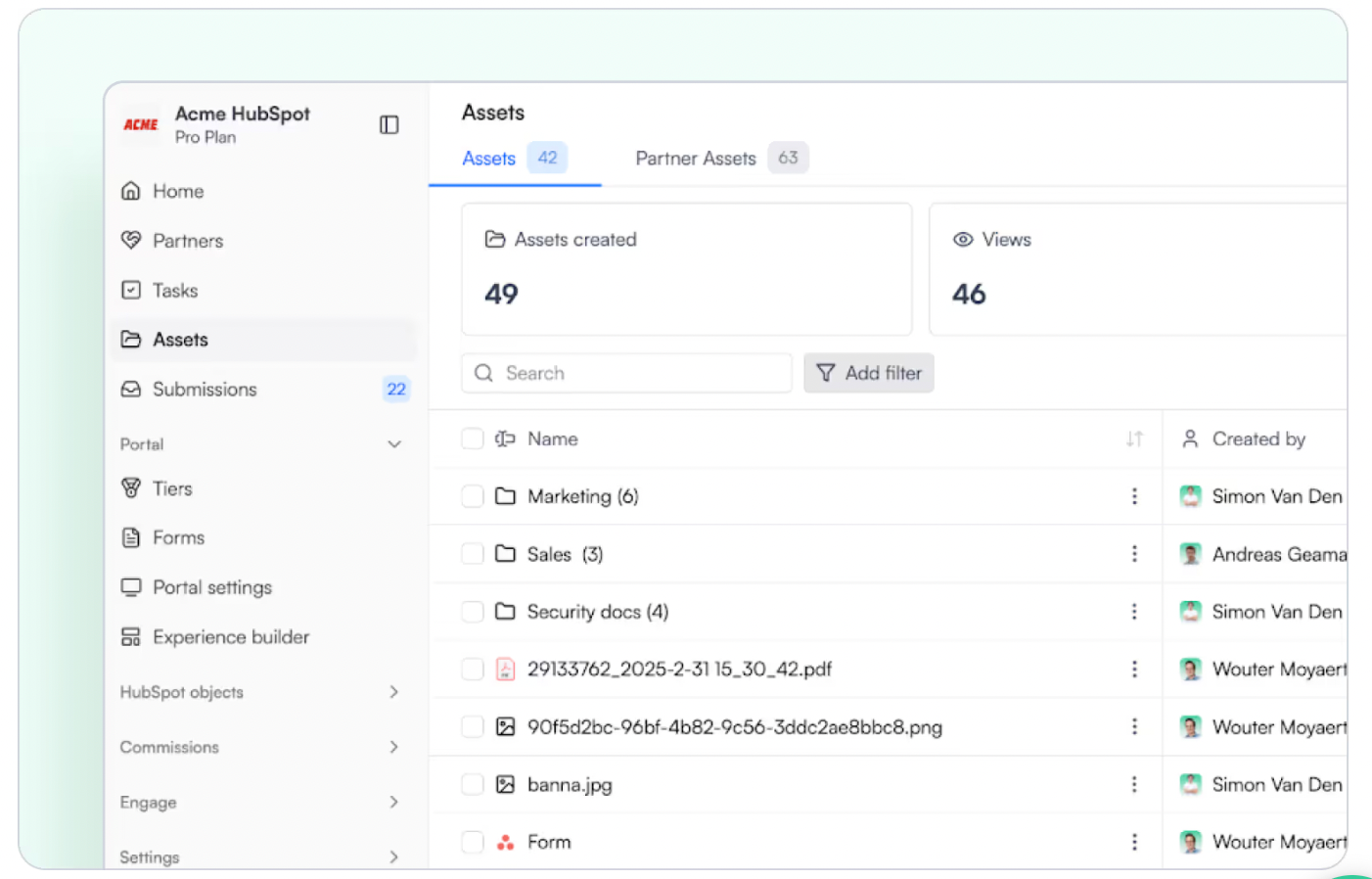
For your co-sell ecosystem to operate effectively, partner sales reps must be able to talk confidently about your joint solution.
While marketers are generally well-briefed on the products they’re expected to build campaigns around, you must understand the importance of informed salespeople.
Actions
Put all stakeholders – including partner AEs – on role-based learning paths, where they are given the exact materials they need to do their job.
For example, you could provide partner sales reps with enablement materials like:
- Bite-sized talk tracks
- Objection handling guides
- Competitive intelligence
Top tip: build out a ‘first-call win kit’, containing pitch scripts, battle cards, and mini demo flows.
These kits aim to help AEs succeed immediately, helping them overcome any initial hesitation and motivating them to reach out to more prospects.
How Can Introw Help?

Introw supports partner sales enablement through its content hub, where all your resources can live.
You can also utilize its content usage analytics to identify which materials are most engaging to users.
10. Align Incentives to Outcomes

When it comes to reward, successful partner programs go way beyond just deal commission.
Instead, they recognize the full range of contributions that drive revenue.
This approach motivates partners to stay engaged across the entire lifecycle, not just at the point of closing deals.
Actions
Consider adding certification bonuses for trained sellers, SPIFFs for short-term performance pushes, and credit for both sourced and influenced deals.
When it comes to incentives, transparency is key.
Publish clear rules around your rewards and revisit them quarterly to ensure they continue to align with your business goals.
How Can Introw Help?
By automatically capturing partner activity and revenue impact, Introw helps to ensure recognition and payouts are accurate and fair.
11. Instrument Engagement as a Leading Indicator

Looking for an early indicator of partner success?
Take your focus off revenue for a second and look at engagement metrics instead.
Actions
Track engagement metrics like:
- Portal visits
- Content downloads
- Email/message opens
- Email/message click-through rates
- Email/message replies
- Meeting attendance
These metrics will show you which partners are actively leaning in.
Now, convert your results into an engagement score.
Partner managers should use this score to decide which partners to prioritize (aka, which are most likely to deliver results?).
How Can Introw Help?
Use Introw to feed your engagement data into role-based dashboards in Salesforce or HubSpot.
12. Run Data-Driven QBRs
In 2026, your Quarterly Business Reviews (QBRs) should have moved beyond static slide decks to live CRM dashboards.
This empowers you to put a strong focus on real, actionable insights, while making reviews more collaborative and, vitally, grounded in facts rather than anecdotes.
Actions
Harness the power of live dashboards to analyze key metrics such as:
- Win/loss ratios
- Stage leakage
- Deal velocity
- Recommended next-best actions
13. Map Ecosystem Opportunities
To truly maximize the tangible benefits of your partnerships, it’s essential to connect with complementary players within the ecosystem.
Consider how you can create complementary triads within your ecosystem.
Your product + an Independent Software Vendor (ISV) + a systems integrator (SI) = bigger, stickier deals.
Actions
To uncover the best triads, run overlap analyses on your customer bases to find out which partners share a similar audience.
Once you’ve identified your complementary trio, build packaged offers that combine all your strengths, and create reference architectures that show how all your solutions fit together.
How Can Introw Help?
Introw lets you tag and add notes by partner type, making it easier to spot potential bundle plays.
This transforms isolated partnerships into ecosystem-driven opportunities with a greater impact.
14. Protect the Partner Experience
A strong partner experience hinges on high levels of trust and smooth, easy interactions.
Clear communication and fast responses are crucial to this.
Actions
While establishing clear and quick communication may feel like an easy win, it’s vital to create a strong structure to avoid lapses in your strategy.
There are three key components to a strong partner comms strategy:
- Establish a response-time SLA
- Lay out a defined escalation path for urgent issues
- Develop a feedback loop to capture partner input continuously
How Can Introw Help?
Introw supports the partner experience by sending automated status updates and running NPS-style pulse checks.
15. Iterate Ruthlessly
To maximize the impact of your partner program, keep a laser-sharp focus on what is working and what is not.
Be ruthless here: double down on the tactics that are producing results, and cut those that aren’t.
Actions
Here’s what this might look like:
- Implement monthly performance reviews
- Run A/B tests on content and campaigns
- Pilot new tiers or programs to see what resonates
- Sunset low-ROI motions
- Double down on high-ROI partners and plays
How Can Introw Help?
Introw provides performance snapshots and trend alerts, helping users to spot both successes and drops in engagement quickly, and empowering them to switch up their strategy fast.
The 8-Step B2B Partnership Process (From Recruit to Scale)
Here are eight steps to take you from the recruitment stage of your partnership program to scaling.
1. Identify & Qualify Partners
Start by mapping potential partners against your ideal customer profile to assess their fit and intent.
Assess their market presence, technical compatibility, and willingness to actively engage with you.
This should ensure you focus on partners most likely to drive meaningful results.
2. Recruit With a Crisp Value Exchange & Fast Path To First Win
It’s crucial that you can clearly articulate what partners gain from working with you, from revenue opportunities to partner enablement resources.
Furthermore, you must make it easy for your partners’ sales reps to achieve their first success quickly.
After all, early wins build momentum and trust.
3. Onboard By Motion
Tailor the onboarding process to the type of partner you’re dealing with to facilitate different levels of responsibilities, knowledge, and engagement.
Apply this personalized approach to:
- SLAs
- MAPs
- Resources
4. Enable
Provide partners with ready-to-use marketing assets, including co-marketing kits and seller playbooks.
Your partnership co-marketing kit could include:
- Email templates and social posts
- Landing pages or microsites
- Decks, one-pagers, and case studies
- Logos and imagery
- Brand guidelines
Meanwhile, your seller playbooks may contain vital info on objection handling, competitive intelligence, and talk tracks.
5. Co-sell
It’s time to start selling!
But first, define structured processes for collaborating on shared opportunities.
These processes will need to take into account:
- Deal registration
- Handoffs
- Stage updates
- Conflict rules
6. Measure
The exact metrics you decide to track will depend on your company’s goals and specific circumstances.
However, when measuring the success of partnership programs, it’s beneficial to track partnership metrics surrounding:
- Engagement
- Pipeline
- Revenue
- CSAT/NPS
The resulting data should inform your decisions on where to invest, coach, or adjust your partnership strategies.
7. Review
Your QBRs will likely form the backbone of your review process.
Use these to assess your performance against your business goals, analyse your wins and losses, adjust partner tiers or incentives as required, and identify any risks to your pipeline.
And don’t forget to define next-best actions for both the vendor and the partner.
8. Scale
Finally, it’s time to scale.
Leverage successful B2B strategic partnerships to expand into new geographies or verticals, map opportunities for ecosystem bundles, and enact marketplace plays to increase visibility and adoption.
Metrics & Scorecards That Actually Predict Success
As outlined above, the exact combination of metrics you track will depend on your specific circumstances and goals.
However, when it comes to predicting success, there are a few leading and lagging indicators that are especially valuable.
Leading indicators:
- Engagement score
- Time-to-first activity
- Enablement completion
- Meeting acceptance
Lagging indicators:
- Sourced/influenced pipeline
- Win rate
- Deal velocity
- ARR
- Retention/expansion
Furthermore, here’s an example of the core categories you might want to include in a partner scorecard to track performance:
- Partner fit
- Activity
- Pipeline
- Revenue
- Forecast
- Confidence
One of the best PRM platforms on the market, Introw makes tracking and analysing all this data much easier by providing users with a single source of truth, complete with CRM-native attribution and real-time dashboards.
So, instead of juggling partner portals, spreadsheets, and CRM exports, users get easy access to unified, real-time data, all on one platform.
Here’s what this looks like:
- Single source of truth: All partner activities, from deal registration to co-selling notes, are captured in one location, so sales, marketing, and partner teams are all looking at the same information.
- CRM-native attribution: Partner influence is automatically tied to pipeline and revenue inside your CRM, ensuring that deals are appropriately credited.
- Dashboards: Automated custom dashboards make it easy to run QBRs, track ROI, and make decisions around priorities and investments.
Conclusion
B2B partnerships thrive when you reduce friction, personalize by motion, and measure in CRM.
With a clear partner ICP, motion-specific playbooks, and CRM-first automation, you’ll turn partnerships into a repeatable revenue engine – fast.
➡️ Ready to operationalize B2B partnerships in your CRM? Request an Introw demo.
Partnership Strategy: 10 Steps for Building Stronger Collaborations in 2025
Effective partnerships are a crucial component of sustainable growth in today’s dynamic business environment. In 2025, the teams that win aren’t just signing deals — they’re building a clear partnership strategy that aligns business objectives, streamlines collaboration with external partners, and turns joint marketing efforts into measurable revenue growth. This guide lays out a practical partnership strategy framework, from defining partnership objectives to negotiating a strategic partnership agreement, so two or more organizations can create a mutually beneficial relationship that lasts.
What Is a Partnership Strategy?
A partnership strategy is the structured plan for building strategic partnerships that create mutual success across the entire lifecycle: discovering partnership opportunities, evaluating prospective partners, forming a partnership agreement, operating the relationship, and measuring results. It’s different from ad hoc partnership strategies because it sets partnership goals, defines who does what, and anchors everything in shared data. In practical terms, it answers: what is partnership strategy for our business model; which partner ecosystem fits our market; what roles and responsibilities do key stakeholders own; how will we measure success with key performance indicators; and how do we adapt as market insights and new customers change the plan.
Why Partnership Strategy Still Matters in 2025
SaaS world rewards companies that move fast with other businesses, not just alone. Strategic alliances open new markets, extend your customer base through complementary skills, and accelerate access to new technologies you couldn’t build yourself. Technology partnerships deepen product value; supply chain partnerships stabilize delivery; financial partnerships unlock co-investment in growth. But partnerships only drive business success when they’re managed like a core go-to-market, not side projects. That means a clear strategy, adaptive management to emerging trends, and cross-functional collaboration across senior leadership, sales, marketing, product, finance, and legal. The punchline: a successful partnership strategy turns collaborative efforts into predictable outcomes — revenue, brand visibility, and innovation — while reducing potential risks like channel overlap, misaligned incentives, or stalled integrations.
10 Steps for a Successful Partnership Strategy in 2025
1) Tie the partnership to one business objective per segment
Start with a clear strategy: name the strategic objectives your partnership should serve — new markets, product acceleration, supply chain resilience, or pipeline growth. For each segment (technology, channel, services), choose one primary outcome and the few metrics that prove progress. This avoids vague “collaboration” and creates focus for stakeholders involved. Document partnership objectives, decision owners, and review cadence so everyone understands why this strategic partnership exists and how it advances the organization’s success.
2) Build a short list of right partners using a fit score
Evaluate potential partners against a simple scorecard: strategic alignment to business needs, complementary capabilities, access to respective customers, brand strength, and operating readiness. Include cultural markers like responsiveness and executive sponsorship. Look beyond obvious names; prospective partners in adjacent categories (for example, a data vendor plus a cloud solutions integrator) can unlock competitive advantage through complementary skills. Keep a “no for now” list so business development doesn’t restart from zero next quarter.
3) Define the value exchange before the paperwork
A successful partnership begins with a clear value exchange: what each partner brings (product, market reach, content, sales tools), what each expects (pipeline, co-marketing, integration work), and what each commits to in the first 90 days. Draft the value map first; then translate it into a strategic partnership agreement. This avoids legal-heavy starts with light substance. Outline joint offers, routes to market, pricing, and how you’ll handle shared leads to prevent downstream friction.
4) Set roles, responsibilities, and governance early
Great relationships fail without clear ownership. Name an executive sponsor, a partner manager on both sides, and a cross-functional squad (sales, marketing, product, legal, finance) accountable for day-to-day execution. Create a lightweight governance rhythm: monthly operating review, quarterly strategy checkpoint, and a shared risk log. Agree on escalation paths and response-time expectations so issues don’t linger. When two companies move quickly, clarity beats charisma.
5) Co-build the partnership go-to-market
Partnership development moves faster when there’s a real offer and plan. Package a joint solution with messaging, target accounts, and sales strategies that show how the combined value solves a specific problem. Align joint marketing efforts: a webinar, a customer story, and a field enablement session. Decide who funds what, who owns lists, and how leads are routed. Keep timelines short so momentum turns into pipeline within the first 60–90 days.
6) Make measurement unavoidable
Agree on a small set of key performance indicators: sourced pipeline, influenced revenue, cycle time, win rate, integration adoption, and net revenue retention for joint customers. Track them weekly in your CRM; review monthly together. Add leading indicators such as partner-sourced meetings and asset usage so you can adjust early. Tie incentives to these numbers so teams have shared reasons to act. Boring reporting leads to exciting outcomes.
7) Streamline collaboration in the tools teams already use
Partnerships stall when they require new logins or side spreadsheets. Operate in the systems your sellers and partner teams already use. Keep the partner ecosystem visible in the CRM, use email and Slack to move deals forward, and sync those messages back to the opportunity so history isn’t trapped in inboxes. This is where Introw helps: no-login registration, reply-to-update collaboration, and clean sync to Salesforce or HubSpot keep everyone on the same page without extra effort.
8) Write the first 48 hours of the relationship
Partnership strategy development often forgets day zero. Script the onboarding: kickoff agenda, shared drive links, point-of-contact list, access to training materials, and the first three co-selling actions. Provide sales tools (one-pagers, decks, discovery guides), a short integration brief, and a sample outreach sequence. The faster both teams can run a real motion, the sooner the relationship proves value to senior leadership.
9) Manage risk and resilience openly
Strong partnerships acknowledge potential risks up front: overlapping products, long certification cycles, data-sharing rules, or supply chain constraints. Capture these in a shared risk register with owners and dates. If corporate sustainability priorities or compliance requirements affect the partnership, spell them out early. Clarity on constraints builds trust and prevents surprises that derail otherwise successful strategic partnerships.
10) Iterate the partnership like a product
Market dynamics shift. Treat the partnership like a living product: quarterly backlog, small experiments, and clear retire/expand decisions. Add new technologies or joint features when the data supports it; retire motions that don’t convert. Invite customer success to share post-sale insights so you’re not only winning deals but delivering value to the customer base. Adaptive management turns a good start into long term success.
A Simple Partnership Strategy Framework You Can Reuse
- Discover: map partnership opportunities, evaluate potential partners, and confirm strategic alignment.
- Design: define value exchange, roles and responsibilities, and operating rhythm; draft the partnership agreement.
- Deliver: launch a joint motion with campaigns, enablement, and pipeline targets; measure with shared KPIs.
- Develop: expand what works, fix what lags, and evolve the scope with innovative ideas and market insights.
How Introw Supports Partnership-Driven Success
Introw operationalizes partnership management strategies by keeping collaboration CRM-first. Teams register and track partner progress inside Salesforce or HubSpot, automate updates by email or Slack, and keep joint action plans visible on opportunities and accounts. For partner managers, this reduces swivel-chair work and keeps stakeholders aligned. For RevOps, it maintains clean data and trustworthy reporting. For CROs, it links partnership activities to forecast accuracy and revenue growth — the metrics that matter when you scale building partnerships across categories and regions.
Conclusion
A successful partnership strategy blends clarity and cadence: clear objectives, a disciplined evaluation of the right partners, a concrete plan to reach new markets, and an operating model that runs in the tools your teams already trust. When you do that — and measure what matters — strategic partnerships stop being slogans and start becoming a growth engine. If you want the mechanics to feel easier, consider a CRM-first platform like Introw to streamline collaboration, surface KPIs, and help two companies move as one team.
Partner Lifecycle Management: 8 Key Steps to Optimize Your Processes
Partner lifecycle management is how you turn potential partners into high performing partners — and keep them productive through every stage of the relationship. In 2025, the standouts treat the partner lifecycle as an operating system, not a campaign: a structured approach to recruiting partners, accelerating the onboarding process, establishing clear communication channels, monitoring partner performance, and renewing or exiting with professionalism. Done well, the partner management lifecycle delivers mutual benefits: expanding market reach, steadier pipeline, and long-term success for both sides. This guide lays out a practical playbook you can put to work across various stages of the partnership lifecycle, with notes on where a CRM-first partner relationship management stack (like Introw) simplifies the work.
What Is Partner Lifecycle Management?
Partner lifecycle management (PLM) is the structured management of the entire partner journey — from first contact through onboarding, activation, growth, renewal, or exit. Think of it as lifecycle management for two or more organizations working toward shared outcomes. In practice, PLM coordinates people, processes, and tools so partners receive the necessary resources at the right time: marketing materials when prospecting, sales tools at first opportunity, technical assistance at validation, and ongoing support after the first deal. The lifecycle of partner management commonly spans five stages: attract and qualify; onboard and enable; activate and co-sell; grow and retain; renew or exit. Whether you run a channel partner lifecycle management process, manage a services-led ecosystem, or blend in an affiliate program, the scaffolding stays the same — the emphasis and pacing change by motion and segment. A mature PLM function ties each stage to clear strategy, roles, and measurable outcomes so both companies see progress, not just activity.
Why Partner Lifecycle Management Still Matters in 2025
Partner ecosystems are broader and more specialized than ever: technology alliances, system integrators, services firms, and affiliate programs often collaborate on the same accounts. Buyers expect vendors and partners to move as one team, bringing complementary capabilities and credible local services. That expectation puts pressure on lifecycle management. If your stages are fuzzy or your data is scattered, you’ll feel it fast — slow onboarding, missed handoffs, and deals that stall because two companies aren’t on the same page. Effective partner lifecycle management fixes this by giving every stakeholder a clear map of the journey: how you’ll recruit, enable, co-sell, support, and review. It also anchors the relationship to business growth: shared goals, joint offers, and a cadence of regular reviews that turn activity into outcomes. When the lifecycle is visible inside your CRM, you can track performance, identify areas to coach, and allocate resources to the partners and plays that actually convert. The result is a healthier partner portfolio, stronger relationships, and a predictable route to revenue across new markets and existing accounts.
An 8-Step Framework for Effective Partner Lifecycle Management
Use this structured approach to align shared goals, streamline collaboration, and turn your partner portfolio into sustainable business growth across the full partner journey. Each step builds on the last and can be audited during quarterly reviews.
1) Define Your Ideal Partner Profile and Portfolio Thesis
Strong programs begin by naming the right partners up front. Build an ideal partner profile around business needs (industries, regions, customer base), complementary capabilities (integrations, services, routes to market), and the partner journey you can reliably support. Score prospective partners for strategic alignment, overlap with your respective customers, readiness to co-sell, and senior leadership sponsorship. Then write a simple portfolio thesis: how many partners per segment, which services matter, and where you’ll place early bets. This avoids the “many partners, little progress” trap and keeps resources focused where partnership strategies will pay off. Capture partnership goals, mutual benefits, and first-quarter actions in a one-pager for each target — it speeds quickly from interest to action and helps you maintain professionalism as conversations scale.
2) Standardize Partner Recruitment That Scales
Recruiting partners is a process, not a roadshow. Publish a short, public path for potential partners: a landing page, a qualification checklist, and clear owners for each stage. Mix outreach across your ecosystem — technology partnerships, system integrators, services firms, and (if it fits) a tightly scoped affiliate program. Make it easy to reach potential partners with transparent timeframes and who attends the first stage call. Share agendas and follow-ups with resources so candidates can evaluate fit without friction. Keep a “no-for-now” list and revisit quarterly; the market shifts, and new technologies or emerging trends can change strategic alignment. A repeatable recruitment motion preserves momentum, keeps the experience consistent across regions, and helps you identify the lifecycle of partner management signals that predict success early.
3) Design an Onboarding Process That Accelerates First Value
The handoff from recruiting to enabling is where many programs stall. Build a 30–60 day onboarding process with role-based, comprehensive training (seller, SE, marketer), current marketing materials, and a compact solution certification. Provide a starter kit: one-page positioning, a discovery guide, a 5-slide demo, and two co-brandable assets. Give partners the necessary resources to run their first motion without waiting on your team. Define roles and responsibilities, share a point-of-contact list, and set expectations for deal registration and response times. Close with a brief readiness check — who they’ll target, which sales tools they’ll use, and what success in the first quarter looks like. Well-run onboarding shortens time-to-first-deal, improves partner engagement, and sets the tone for a mutually beneficial relationship grounded in shared execution.
4) Establish Clear Communication Channels and Lightweight Governance
Clarity beats volume. Agree on clear communication channels (email/Slack) and a simple governance rhythm: weekly pipeline syncs during activation, monthly operating reviews, and a quarterly strategy checkpoint. Document owners on both sides — a partner manager, sales lead, marketing lead — and write how to escalate blockers. Keep meetings short and focused on progress, not status. Encourage both organizations to share insights from the field so you can adjust messaging and plays quickly. Lightweight governance helps many partners move in parallel without creating bureaucracy, and it’s a key element of channel partner lifecycle management where multiple vendors may touch the same customer. When communication is structured and visible in the CRM, teams stay aligned and issues surface early, before they threaten deals.
5) Instrument Performance Monitoring With Shared KPIs
You can’t manage what you can’t see. Decide on a short list of KPIs that actually describe partner performance: sourced pipeline, acceptance time for deal registrations, stage conversion, win rate, and adoption of integrations or services. Add health signals like content usage, meeting cadence, and response times. Review data where the work happens — your CRM — so you can track performance without spreadsheets, then coach to specifics: where a partner stalls, which assets work, and which markets convert. Segment reports by various stages of the partner lifecycle so you can identify areas to improve (e.g., partners strong at sourcing but weak at validation). Shared dashboards and regular reviews turn conversations from opinion to plan and spotlight high performing partners for investment.
6) Treat Support and Resources as an Ongoing Process
Effective PLM doesn’t end after onboarding. Partners need ongoing support that matches their maturity: faster answers during early co-selling, deeper enablement as deal sizes grow, and guidance on industry regulations or security for complex accounts. Maintain a living catalog of additional resources — case studies, security briefs, ROI models — and update them as products evolve. Ensure partners receive timely technical help during proofs and clean, co-owned mutual action plans. Give customer success a clear role in the partnership lifecycle so joint wins become references and renewals. The goal is a steady experience that reinforces trust and keeps engagement high across the lifecycle of partner management.
7) Run Joint Plays That Expand Market Reach
Activation sticks when both sides see pipeline. Package one or two joint plays aimed at new markets or specific use cases: a webinar with a follow-up sequence, a field workshop for an account list, or a services-plus-product bundle. Align on routes to market, lead flow, and attribution so mutual benefits translate into revenue growth and brand visibility. Combine complementary capabilities — a cloud solution with a compliance specialist, for instance — to strengthen the business relationship and create partnership success with clear offers. Share wins publicly; it motivates teams and gives the next partner a model to follow. Over time, a few proven plays will do more for business growth than a shelf full of unused assets.
8) Review, Renew, or Rotate With Data
End each quarter with a concise review: what worked, what lagged, and one change to test. Decide whether to renew, expand scope, or pause. If you renew, raise the bar with new partnership objectives and a larger target list; if you exit, keep a documented handover and protect customer experience. A respectful close protects your reputation and may reopen doors later. This adaptive management approach keeps your partner portfolio healthy, aligns investment with results, and ensures your PLM remains a comprehensive approach — not a set-and-forget checklist.
Metrics & Dashboards That Keep You Honest
A clean measurement layer is the difference between anecdotes and accountability. Tie the channel partner lifecycle management process to a handful of outcome metrics (sourced pipeline, bookings, cycle time, win rate, expansion on joint accounts) and a few leading indicators (registrations responded to within 24 hours, mutual action plans created in first meeting, enablement completions). Track by stage of the partner management lifecycle so you can see where partners speed quickly or stall. Layer in program health signals — active partners by segment, ramp time, content adoption — so you can plan capacity and resources. The goal isn’t a flashy BI stack; it’s a dashboard you trust enough to make decisions weekly. When your key takeaways are visible to the key stakeholders who own sales, marketing, and success, the program improves continuously instead of once a year.
Conclusion
Partner lifecycle management is a comprehensive approach to turning partnership intent into durable results. Define who you’ll work with, start them quickly, keep communication and governance light but consistent, measure what matters, and renew relationships with confidence — or close them cleanly. When you operate the lifecycle inside your CRM and design for adoption, you get mutual success: stronger collaborations, predictable pipeline, and customers who experience coordinated service from first meeting through renewal. If you want the mechanics to feel easier, consider Introw’s CRM-first PRM to keep the work simple and the results visible.
GTM Partnerships Guide 2025: Best Practices and Strategies
GTM partnerships are now core to how most companies reach a target market, launch products, and expand revenue streams. When you combine complementary strengths — channel partnerships, technology integrations, service partners, and referral partners — you create a go to market strategy that wins trust faster and serves the end customer with a more complete solution. This guide lays out practical frameworks, real-world plays, and key performance indicators so partnership leaders, marketing teams, and sales reps can run GTM with partnership discipline rather than ad hoc coordination.
Why GTM partnerships matter in 2025
Routes to market have multiplied, buying committees have grown, and product offerings often depend on new technology delivered by third party partners. In this environment, one company rarely brings everything the target customers need. Strategic partnerships help you reach new markets, lower customer acquisition costs, and turn niche partner capabilities into a competitive advantage. Channel partner programs extend distribution, technology partnerships improve product fit, and service partners make adoption stick. When the motion is run well, both you and your trusted partners share measurable business outcomes — revenue growth, higher win rates, and happier customers — while the end customer enjoys a unified experience across discovery, purchase, and support.
What counts as a GTM partnership
A GTM partnership is a structured go to market agreement between two or more organizations to reach a target market together. Common categories include:
- Channel partnerships: value added resellers, distributors, agents, and original equipment manufacturers that resell or embed your product or service.
- Technology partnerships: integrations and joint solutions with cloud services or complementary platforms that create more value than either product alone.
- Service partners: system integrators and consultants who implement, customize, and support the solution for the end customer.
- Referral partners and affiliate program: partners who refer customers and share in fair market value rewards.
- Co-marketing alliances: joint webinars, social media posts, and digital marketing campaigns that generate qualified demand.
The best programs mix these motions deliberately, recognizing that one partner may span multiple roles over time.
A reusable framework for GTM with partnership
Think in four phases that repeat throughout the partnership program.
1. Discover and select right partners
Define your partnership strategy and selection criteria: target audience overlap, complementary capabilities, fair market value terms, product market fit alignment, and ability to execute. Score potential partners and run a small pilot before committing.
2. Design the offer and the plan
Write a joint value proposition, map the sales process, and package a combined offer. Clarify intellectual property boundaries, pricing ranges, and how you will refer customers between teams. Agree on key performance indicators early so progress is visible.
3. Deliver the plays
Launch two or three simple plays first — a co-marketing campaign, a referral motion, and a co-sell sequence for top accounts. Share training resources and marketing content so both teams can operate without waiting on approvals.
4. Develop and expand
Inspect results monthly, reward performance, and double down on what works. Rotate out low-yield motions and add new markets or segments when the data supports it.
Seven high-impact strategies that work now
1) Build a joint value proposition customers can repeat
Target customers need to hear one clear story. Combine positioning from both companies into a plain-language promise: who the solution is for, the problem it solves, and why the joint approach delivers more value. Pressure-test with three real world examples — one from a current customer, one from a recent win, and one from a pilot. Keep a one-page version for sales reps and a five-slide version for product or service demos.
2) Stand up a co-marketing engine in 30 days
Launch a quarterly campaign together: one webinar, one customer story, and three social media posts supported by a lead-capture page. Divide responsibilities so the marketing team at one company runs creative while the other drives list building and follow-up. Track cost per registration, show rate, and opportunities created to ensure lower customer acquisition costs rather than vanity metrics. Repurpose content across channels and localize where your GTM partners have stronger market reach.
3) Make deal registration and routing effortless
If partners cannot register interest quickly, you will miss momentum. Offer no-login forms, email-to-register, and automatic record matching in the CRM. Route by territory and segment, and confirm acceptance within 24 hours. Publish response-time SLAs and compensation basics so the fair market mechanics are transparent. The administrative layer should never slow the buyer journey.
4) Enable both sides with the same playbook
Provide joint training resources that keep teams aligned: discovery questions, a product or service demo path, objection handling, and a short integration brief for the IT department. Record a call teardown for a real opportunity so sellers hear what good sounds like. Add role-based micro-learning for channel partners and system integrators who need deeper technical content. Update the content monthly and retire stale assets.
5) Run a simple co-sell sequence for named accounts
Choose ten accounts where both companies already have traction. Map contacts, confirm the value proposition, and stage a three-step sequence — joint intro, discovery, and proof. Keep a mutual action plan on the opportunity so everyone sees owners and dates. This play consistently accelerates direct sales cycles and increases sales conversion by adding the right partners at the right moment.
6) Design incentives that reward performance, not activity
Pay for outcomes that matter: sourced opportunities accepted, closed-won revenue, and verified expansion. Tie referral partners to clean qualification and fast handoffs. For channel partner programs, align discounts and market development funds to pipeline and bookings, not just logo tiers. Publish how you measure fair market value and how you will review it annually, especially if subscription models shift the revenue timing.
7) Package services to make adoption easy
Even great integrations stall without hands-on help. With service partners and system integrators, publish two implementation bundles — essential and advanced — with timelines and responsibilities. Co-price where appropriate and clarify who invoices. This removes ambiguity for the end customer and protects margins for both companies.
KPIs that prove the GTM partnership is working
Measure a short list that leadership believes and front-line teams can influence.
- Pipeline created by partner type and segment
- Acceptance time and conversion for registered opportunities
- Win rate and average selling price for co-sell versus direct sales
- Cycle time from first joint touch to close
- Attach rate for integration or services on new customers
- Customer satisfaction and early retention for joint wins
Review weekly internally and monthly with partners. Use the numbers to tune messaging, shift resources, and decide where to add additional revenue streams or where to pause.
Governance and operating rhythm
GTM partnerships succeed when the cadence is predictable. Set a monthly operating review and a quarterly steering session. Document decision owners, escalation paths, and how conflicts get resolved. Keep a single partnership plan that lists shared goals, campaigns, and account plays. One partner should own scheduling — alternating quarterly keeps things balanced. When roles are clear and the calendar is steady, collaboration scales without friction.
Tech stack and where Introw fits
Operate where work already happens — the CRM. Deal registration, attribution, and partner activities should live on opportunities, accounts, and contacts. Use email and Slack to communicate, but sync replies back to records so nothing lives only in an inbox. Introw supports this CRM-first operating model: partners can register deals without a portal, updates flow through everyday channels, and dashboards show KPIs by partner, play, and stage. That alignment helps partnership leaders manage GTM partnership motions alongside direct sales without swivel-chair work.
Putting it together: a 60-day starter plan
Weeks 1–2: finalize partner selection, agree on KPIs, and draft the joint value proposition.
Weeks 3–4: assemble training resources, set up registration and routing, and schedule the first webinar.
Weeks 5–6: launch the campaign, run joint discovery on top five accounts, and publish a mutual action plan template.
Weeks 7–8: review results, reward performance, and decide whether to expand the play, shift segments, or add a second partner.
Conclusion
GTM partnerships turn complementary strengths into market impact. When you choose the right partners, agree on a clear plan, and measure the outcomes that matter, you lower acquisition costs, reach new markets, and ship a better customer experience. Keep the operating system simple — shared KPIs, steady cadence, and CRM-first execution — and your GTM strategy will scale across channels, technologies, and regions. If you want the mechanics to feel lighter, consider Introw to keep the data clean, the collaboration easy, and the results visible.
The Ultimate Guide to Channel Partner Management in 2025
Effective channel partner management is the backbone of every successful SaaS partner program. In 2025, winning teams are moving far beyond static portals and manual spreadsheets. Instead, they’re combining clear channel strategy, consistent communication, and CRM-first execution to turn channel partners into a dependable source of pipeline and revenue growth. In this guide, you’ll find practical frameworks, best practices, and tools to help you build a solid foundation, motivate partners, and run an operating model that scales across multiple vendors, motions, and regions. Along the way, we’ll show where Introw’s partner relationship management approach fits when you want less friction and more shared truth.
What Is Channel Partner Management?
In B2B SaaS, channel partner management is the ongoing, two-way system for recruiting the right partners, enabling them with training resources, aligning on business objectives, and collaborating to win and retain customers. It’s broader than enablement and deeper than a partner portal login count. It covers the business relationship and the business model: how partners sell, how you reward partners, how you prevent channel conflict, and how you measure partner performance across the customer lifecycle. Engaged partners submit qualified deals, join joint business planning sessions, co-host campaigns, and escalate risks early. A capable channel partner manager orchestrates these motions, balancing sales techniques with program design so third party partners can move quickly without sacrificing data quality. The outcome you’re after isn’t activity for activity’s sake; it’s mutual support, new customers, and sustainable revenue.
Why Channel Partner Management Still Matters in 2025
Signing new partners is easy; managing channel for mutual success is the real work. Competition is intense, partner ecosystems are crowded, and buyers expect coordinated experiences across software, services, and integrations. If you don’t keep partner relationships active — through timely updates, useful marketing materials, and clear sales support — enthusiasm fades, channel conflict rises, and deals quietly stall. The best programs treat partners as an extension of the sales team, not a parallel track. They publish sales targets and key performance indicators, make the entire partner lifecycle visible in the CRM, and keep the same page across partner managers, AE, and RevOps. When you track partner progress alongside direct motions and tie activities to outcomes, you get faster cycles, cleaner attribution, and reliable forecasting. Introw’s stance is pragmatic: meet partners where they already work, sync everything back to Salesforce or HubSpot, and let automation handle the nudges so humans can focus on selling.
10 Proven Strategies for Managing Channel Partners in 2025
1) Meet Partners Where They Work
Reduce friction by engaging partners through the tools they already use — email, Slack, and the CRM. Replace “please log in” moments with no-login updates and reply-to-update workflows. Introw enables off-portal collaboration so partners can respond from their inbox and have that context land on the opportunity. The result: higher partner engagement, fewer missed signals, and faster decisions.
2) Make Deal Registration Frictionless
Short forms, clear rules, instant confirmation. Let partners register via link or email and auto-attach submissions to the right account with deduplication. Acceptance SLAs should be visible so a partner manager isn’t chasing status. When registration is simple, partners sell earlier, attribution is clean, and your sales team can prioritize correctly.
3) Align on a Few KPIs and Inspect Weekly
Pick a concise set of key performance indicators that tie to outcomes: partner-sourced pipeline, time from registration to acceptance, stage conversion on co-sell deals, average discount, and renewal or expansion on shared accounts. Review weekly internally and monthly with partners. Action beats dashboards: agree on one change per review and track the effect.
4) Personalize Enablement by Segment
Managed service providers often need deeper technical support and services packaging; resellers want campaigns and pricing clarity; referral partners need fast handoffs. Segment by type, tier, and region, then tailor training materials, sales strategies, and incentive programs accordingly. Keep everything easy to find and easy to reuse.
5) Standardize a Mutual Action Plan
Create a simple plan template for every registered opportunity: owners on both sides, next three steps, and dates. Keep it inside the CRM so partner activities and internal tasks live together. This turns “let’s sync later” into concrete progress and keeps independent entities rowing in the same direction.
6) Reward the Behaviors That Win
Develop incentive programs that favor early, qualified registrations, first-meeting mutual action plans, and clean data. Pay on time and publish status so finance doesn’t become the help desk. Balance sourced and influenced models to prevent noise. When rewards mirror reality, you’ll see improved partner performance without adding complexity.
7) Run Targeted Campaigns, Not Blasts
Use your segments to deliver timely announcements, co-marketing offers, and marketing materials that match the partner’s audience. Track opens, clicks, replies, and pipeline created so you can double down on what works. Partners feel valued when outreach is relevant and light on ceremony.
8) Prevent Channel Conflict With Written Rules
Define protection windows, duplicate logic, and escalation paths. Keep decisions quick and documented in the CRM. Clear, enforced rules lower drama and safeguard long term relationships — especially when multiple vendors and overlapping territories are in play.
9) Coach With Evidence
Replace gut feel with concrete observations: “Your registrations stall at validation; let’s tighten discovery and bring technical support earlier.” Use conversation snippets, win-loss notes, and customer data patterns to improve talk tracks. Share learnings across partners so valuable insights travel.
10) Close the Loop and Celebrate
Publish small wins, share what changed because of feedback, and highlight partner reps who moved a deal. Recognition compounds motivation. A simple monthly roundup does more for partner relationships than another generic webinar.
Tech Stack & Frameworks That Actually Help
Modern partner management doesn’t require a maze of tools. Aim for a CRM-first spine that covers registration, collaboration, and analytics. You’ll want automation for updates, no-login access for partners, and real-time engagement tracking so you can measure without chasing screenshots. Introw’s approach is to mirror your sales processes, keep partner portal usage optional, and centralize partner activities on opportunities, accounts, and contacts. That way, track partner progress and revenue attribution live where leadership already inspects the business.
The operate framework
- Engage: meet partners in their tools, send concise updates, and provide sales tools they’ll actually use.
- Measure: tie partner activities to pipeline and bookings, not just logins.
- Optimize: retire low-yield motions, expand plays that convert, and adjust incentives quarterly.
How Introw Supports This Operating Model
Introw brings partner relationship management into Salesforce and HubSpot, letting partners sell without changing their day-to-day habits. No-login deal registration, reply-to-update collaboration, Slack nudges, and role-based dashboards keep everyone aligned. For partner managers, it simplifies managing channel by removing swivel-chair work. For RevOps, it protects data hygiene. For CROs, it links partner activities to forecast and revenue growth — the measures that matter.
Conclusion
Channel partner management in 2025 is a flow, not a checklist. Recruit the right partners, align on a few KPIs, keep communication lightweight and frequent, and make it effortless to register and advance deals. Handle conflict quickly, reward partners for behaviors that move the needle, and keep improving the business strategy with evidence, not hunches. When you operate from a single source of truth and design for adoption, you get mutual success: stronger partner relationships, predictable pipeline, and customers who experience coordinated service from first meeting through renewal. If you want that flow to scale, consider a CRM-first platform like Introw to keep the work simple and the results visible.


.svg)



















